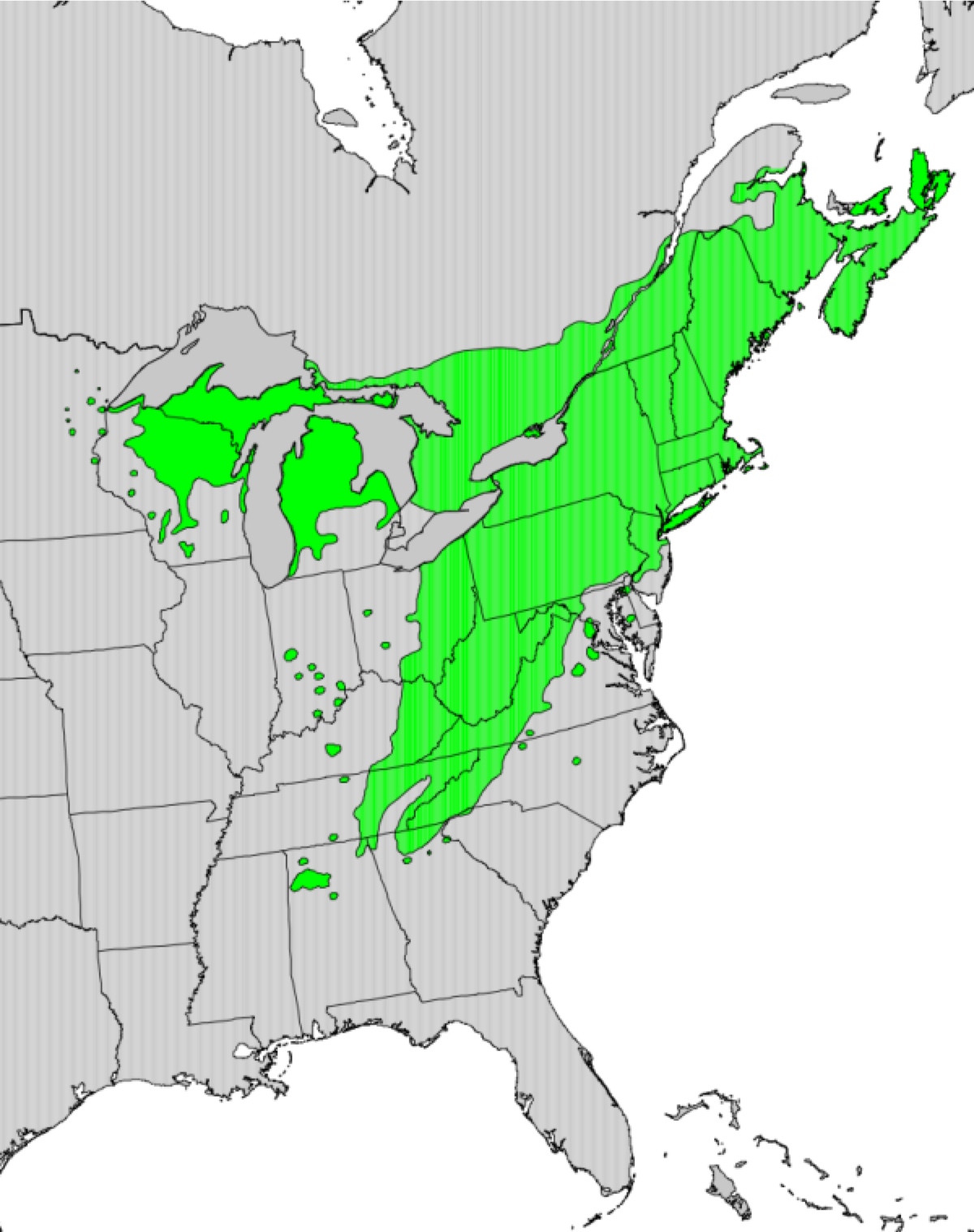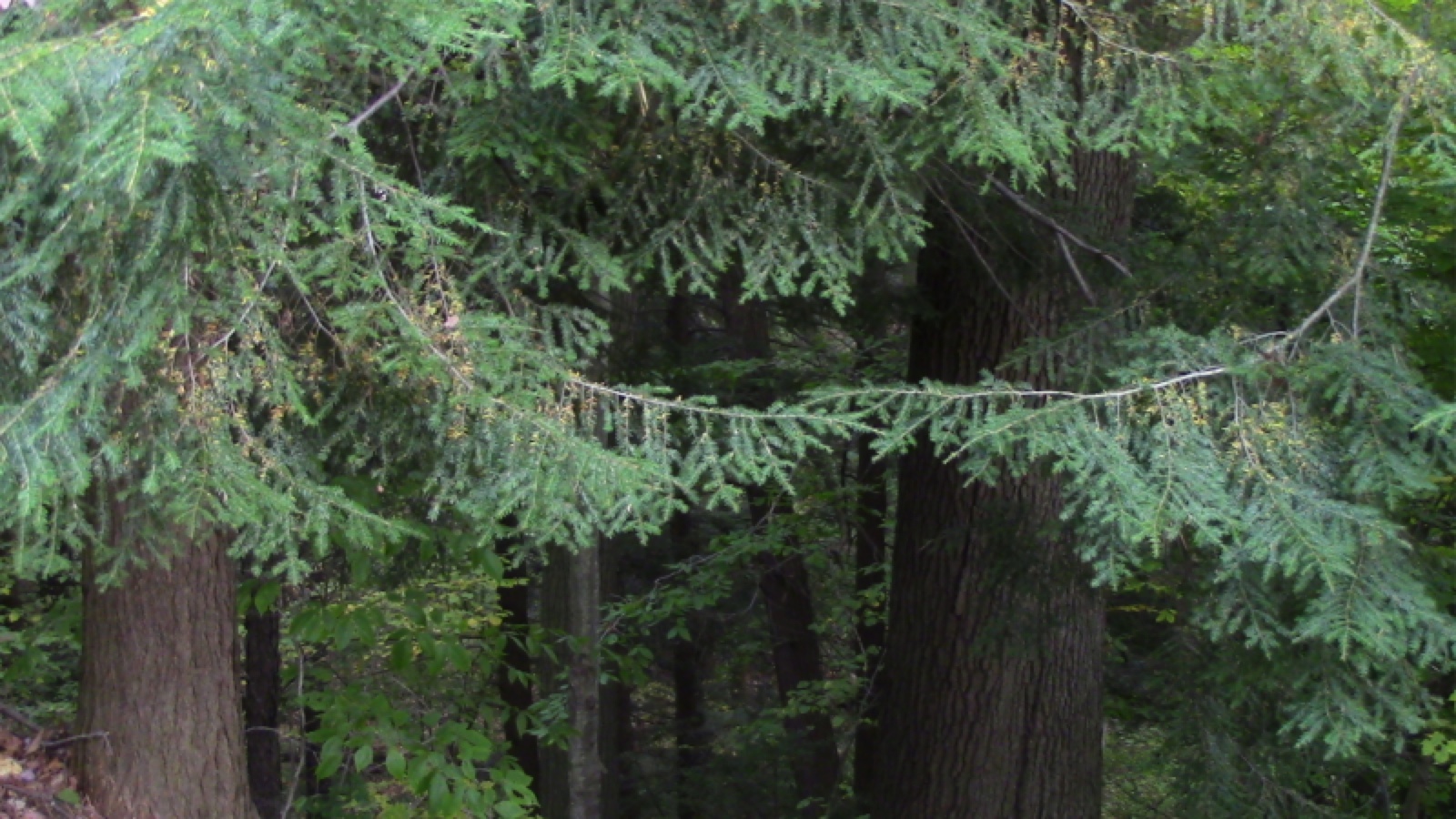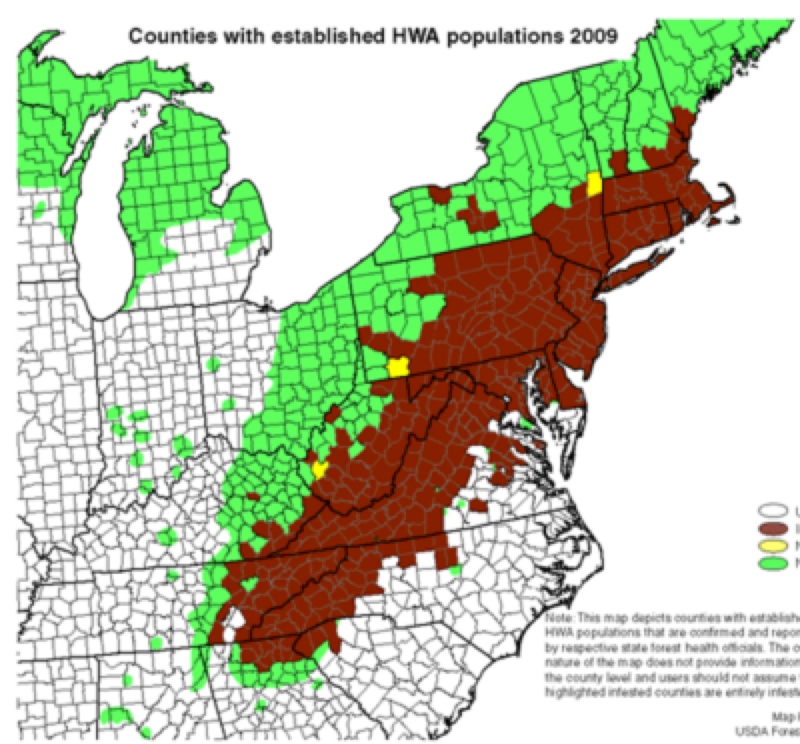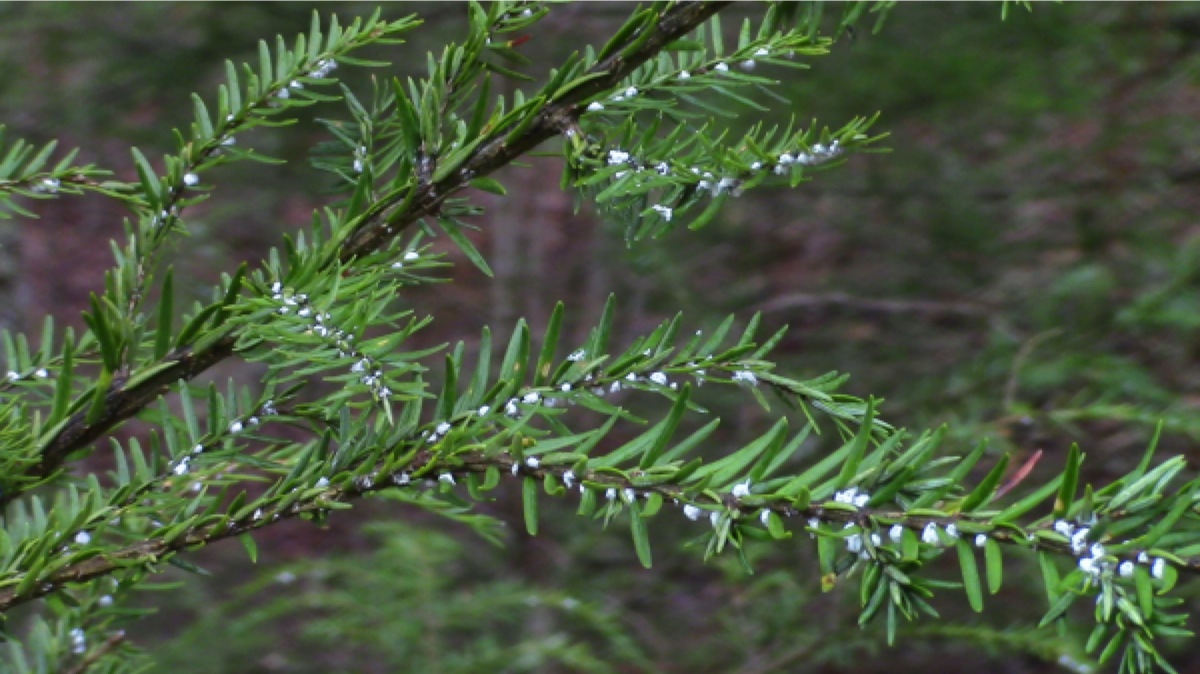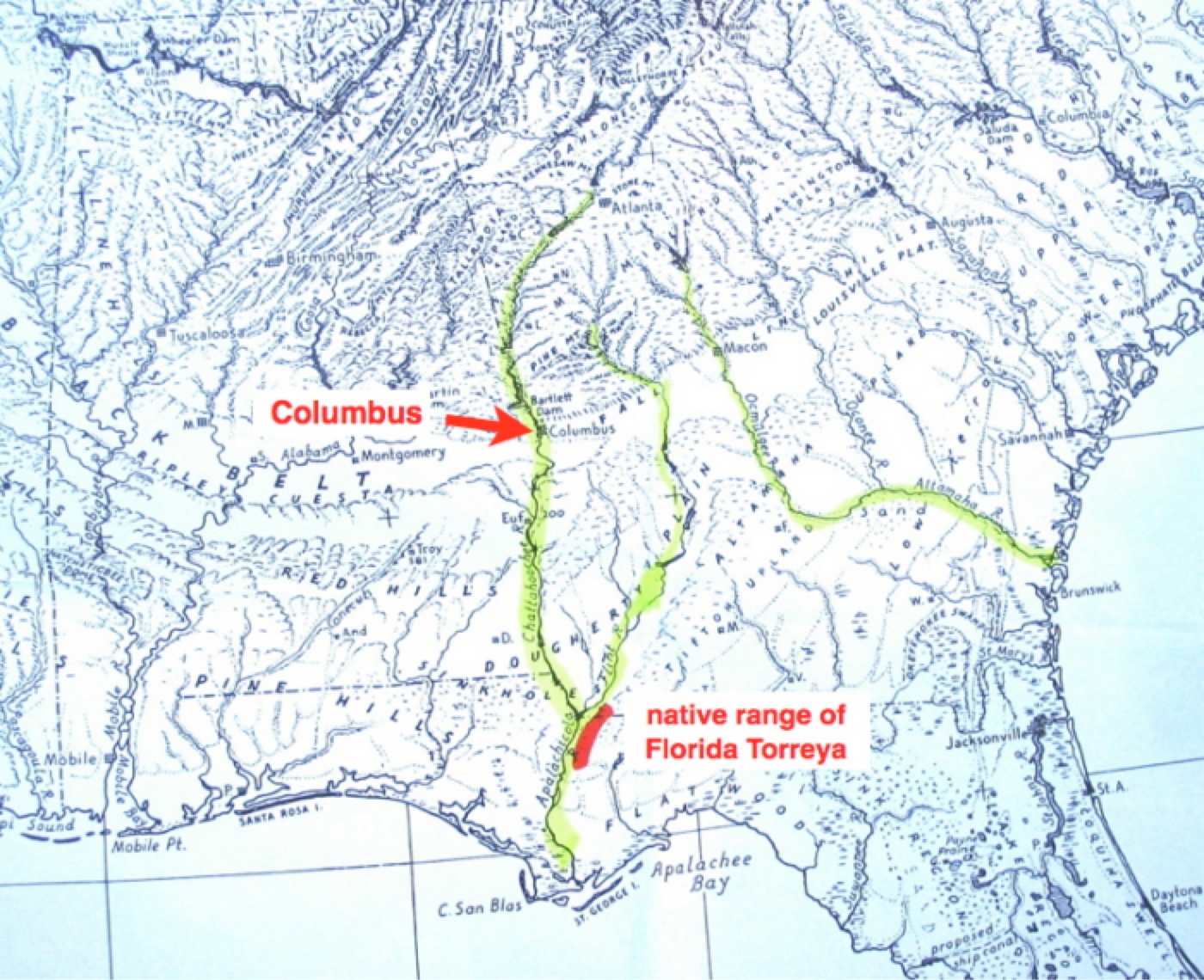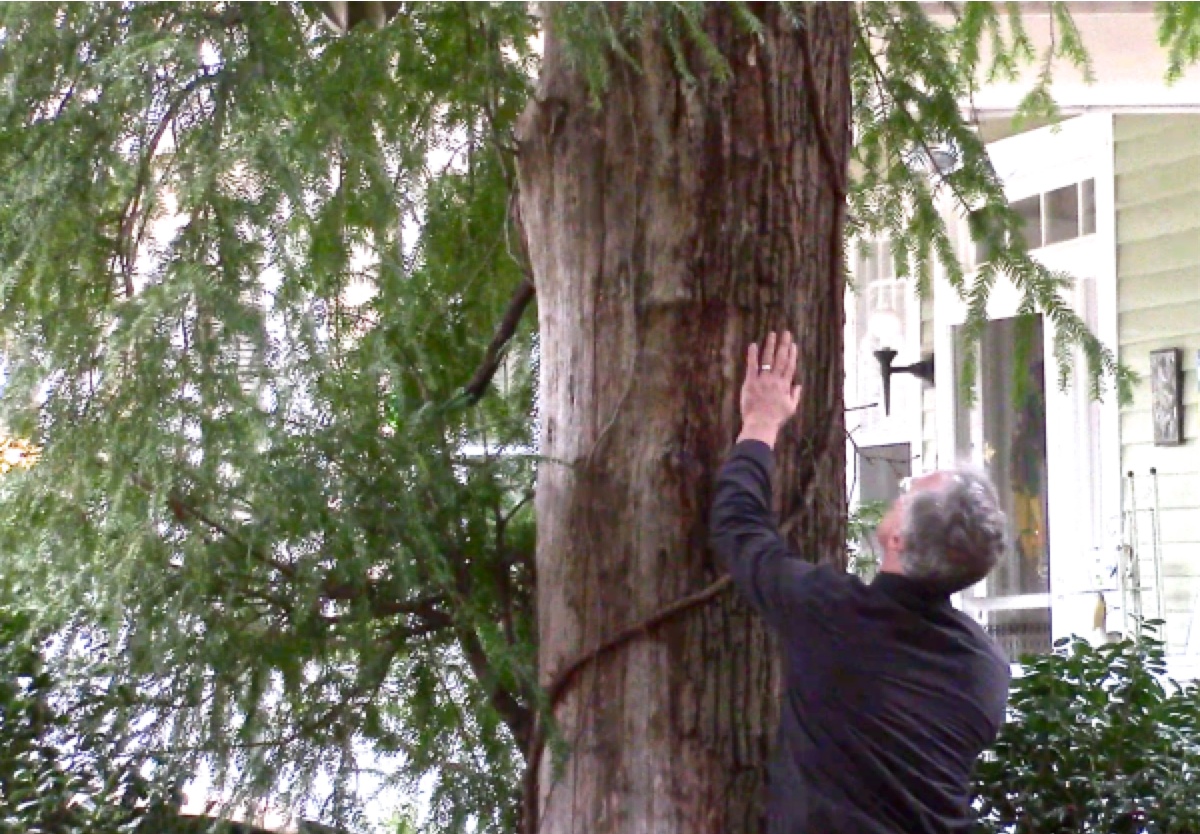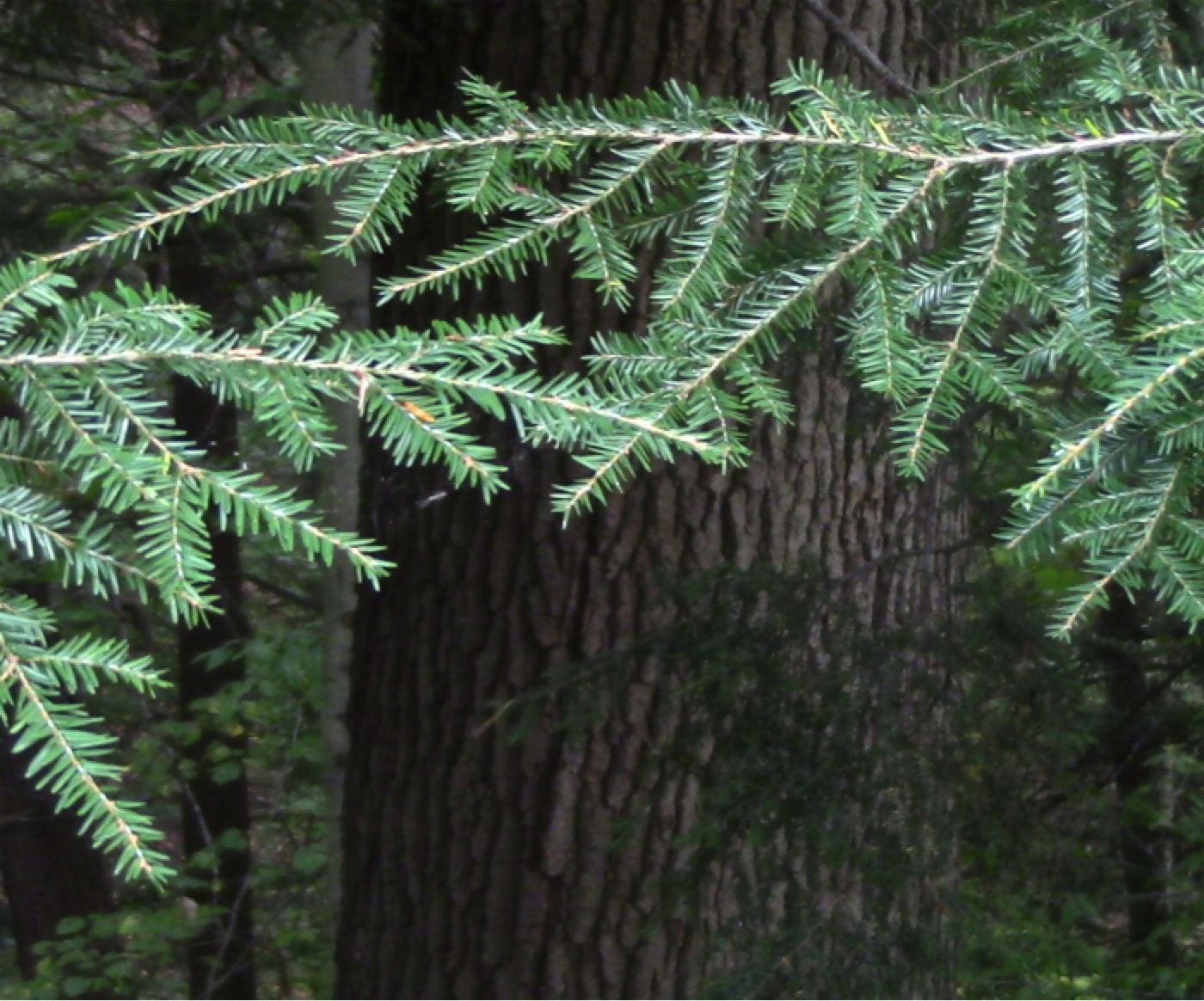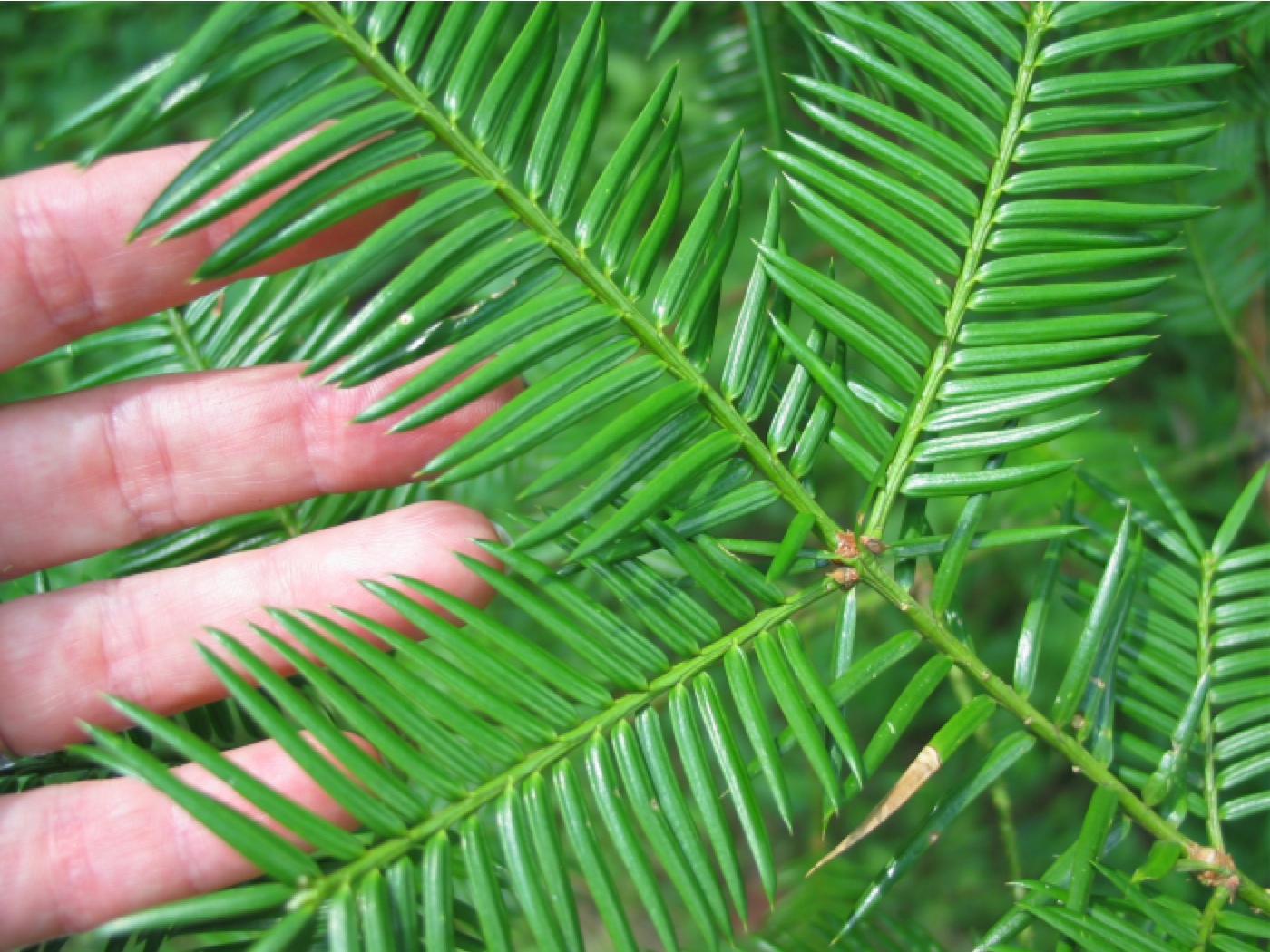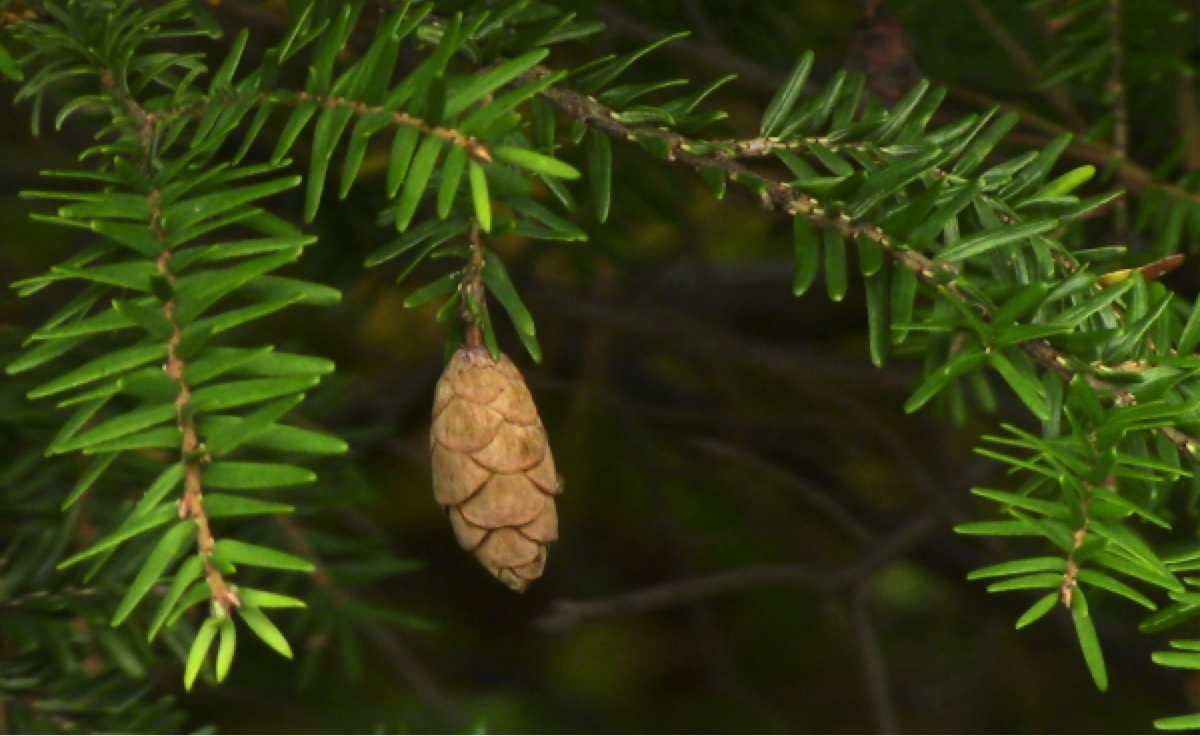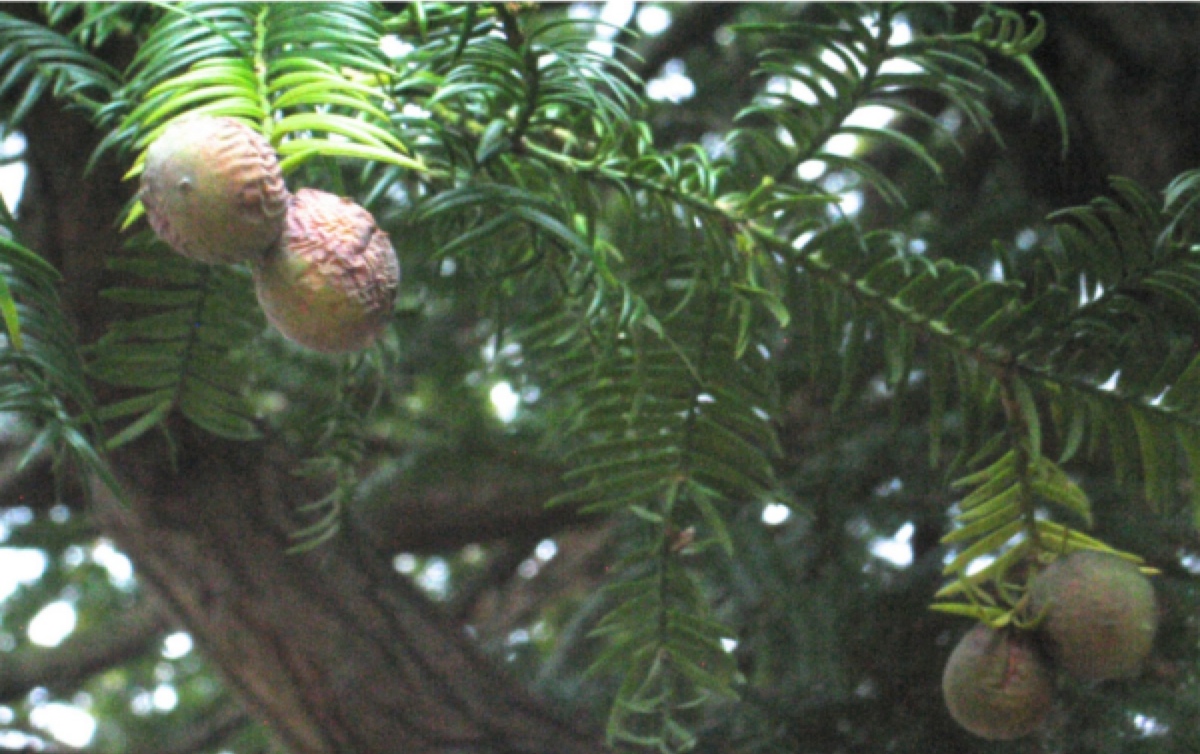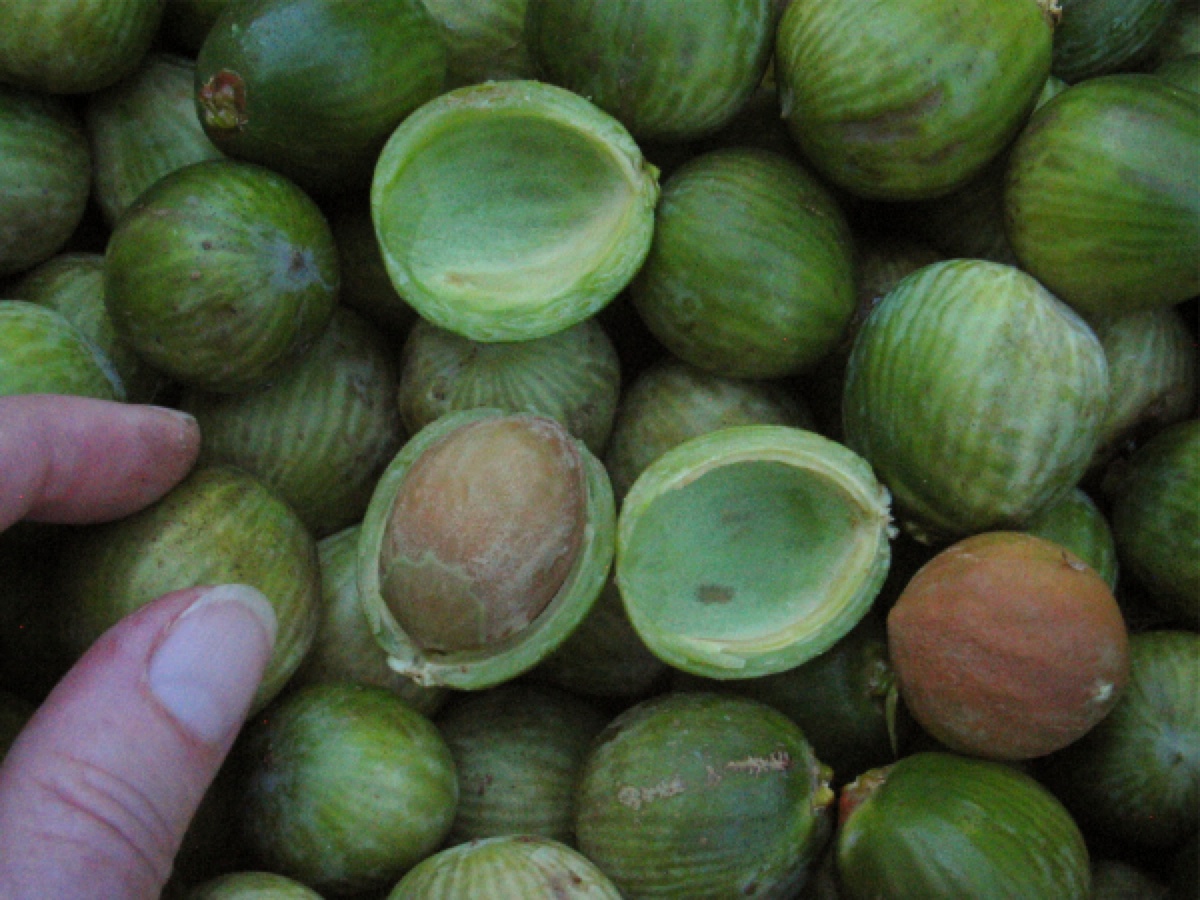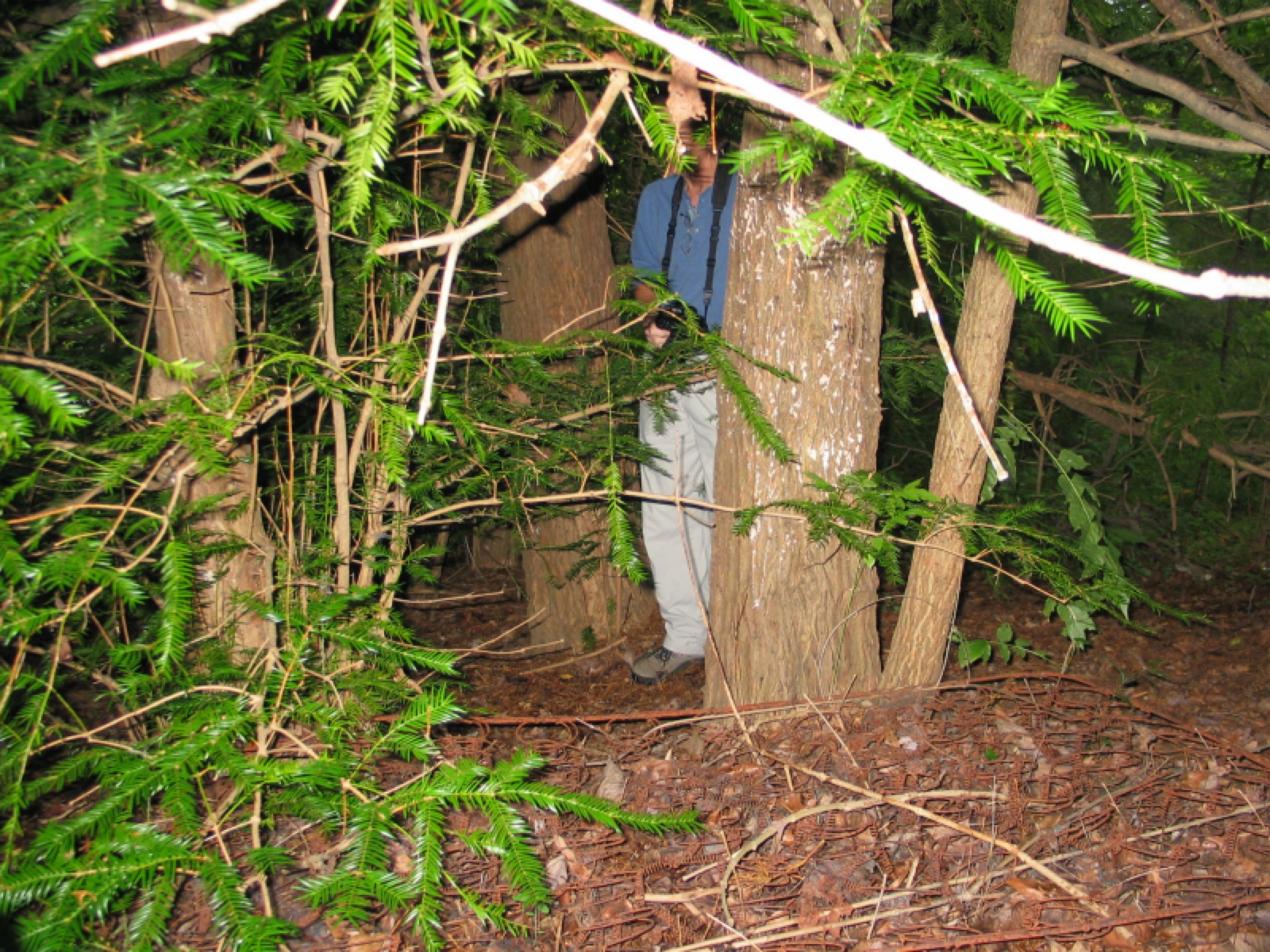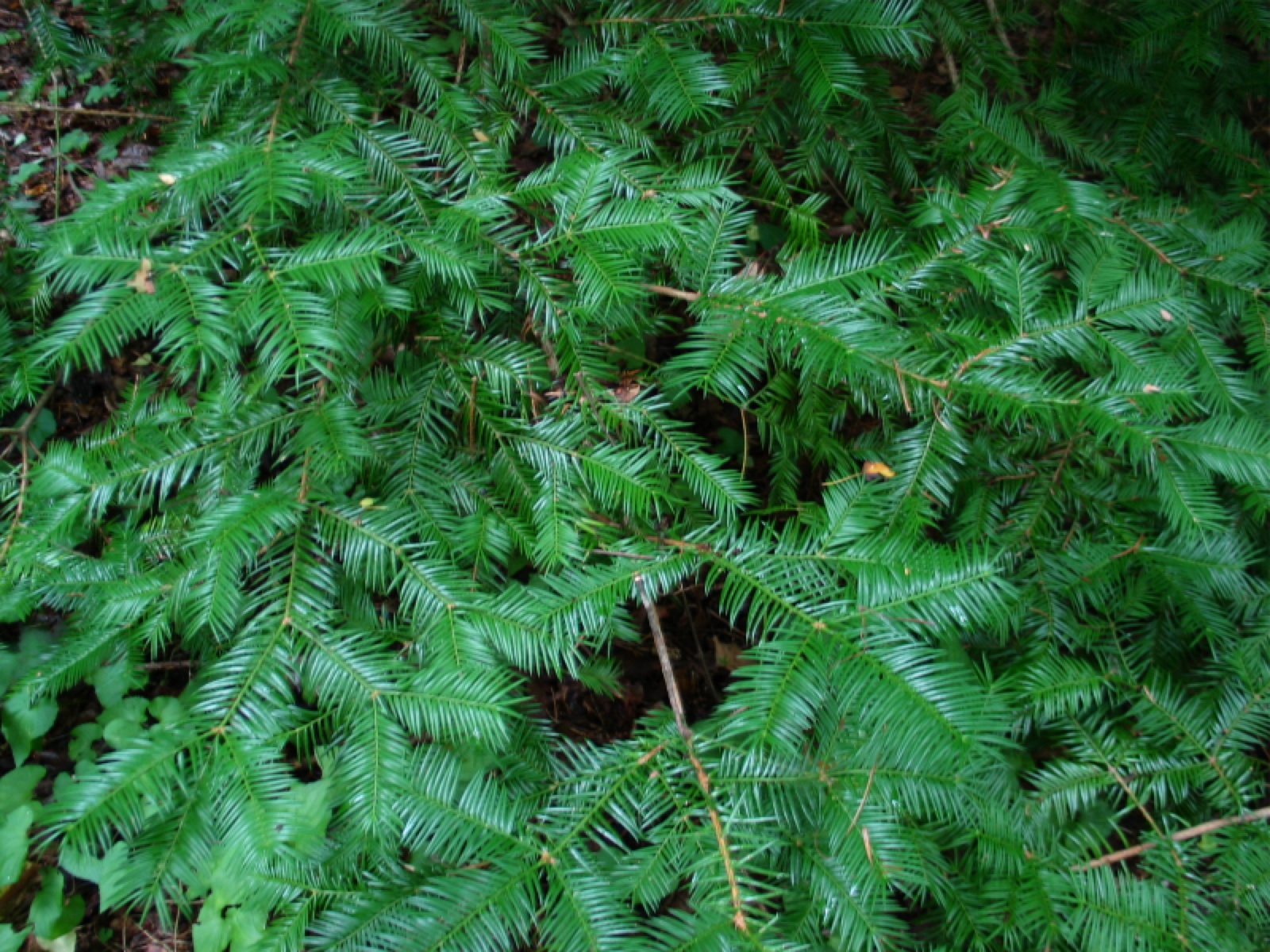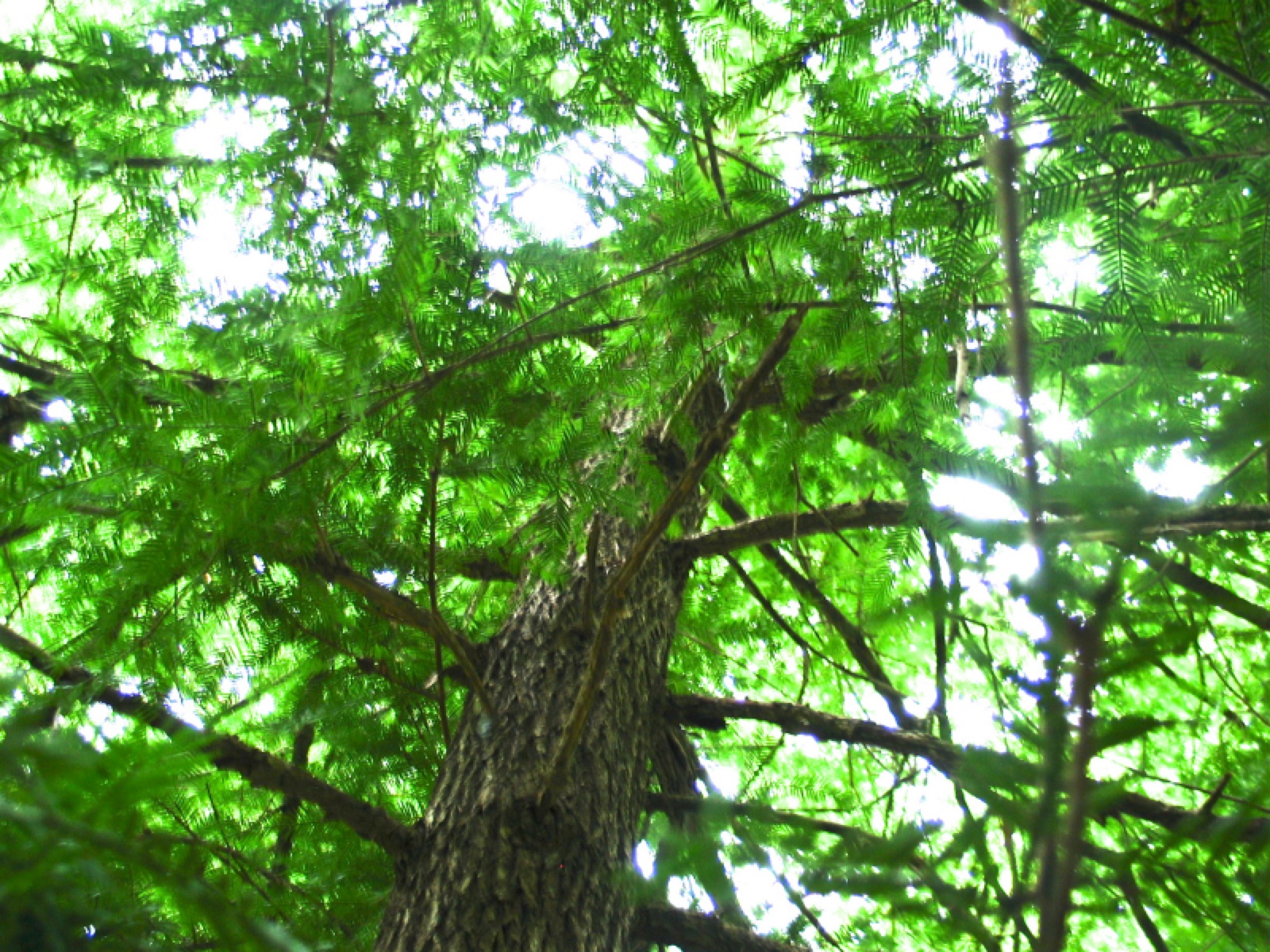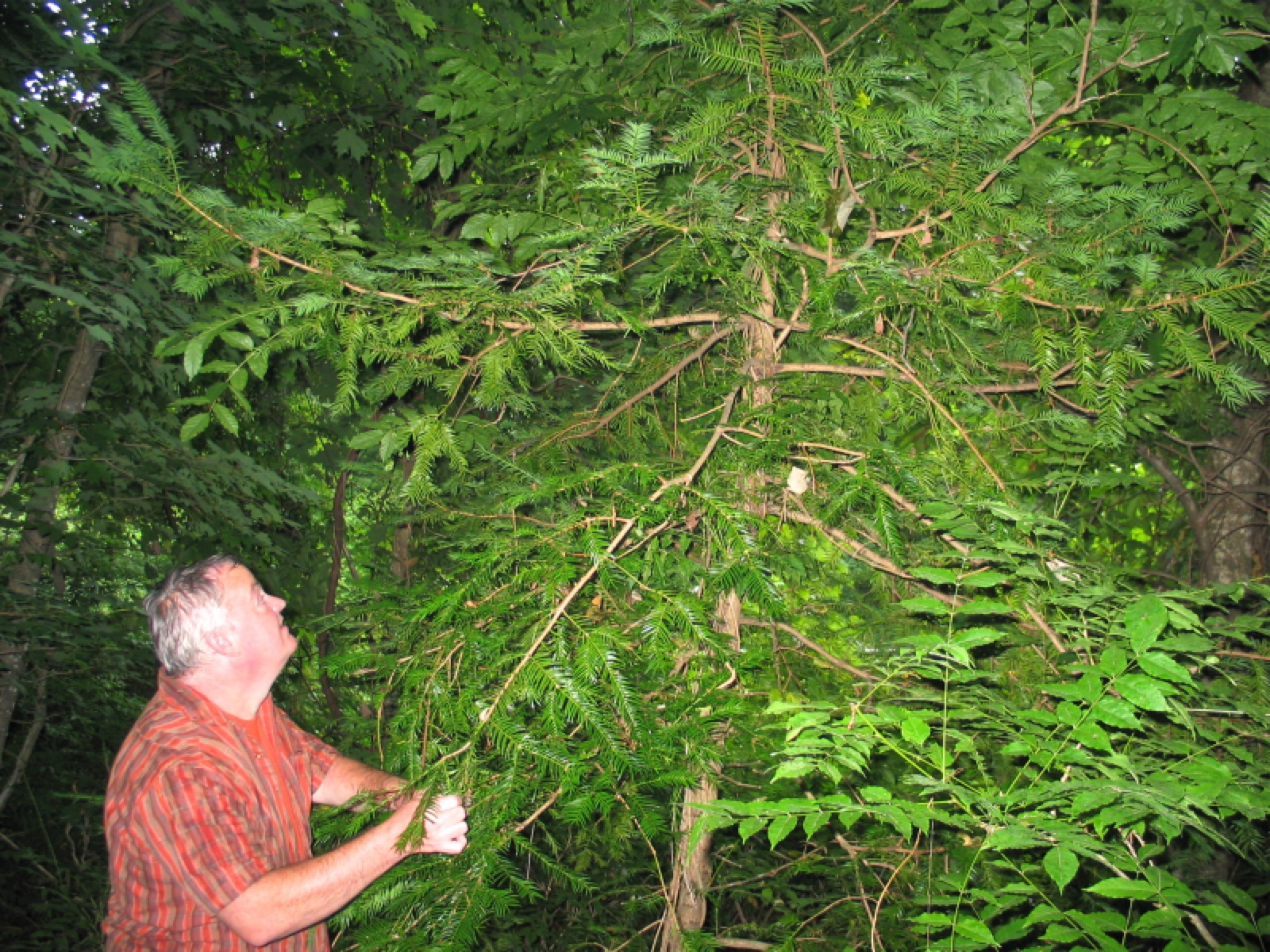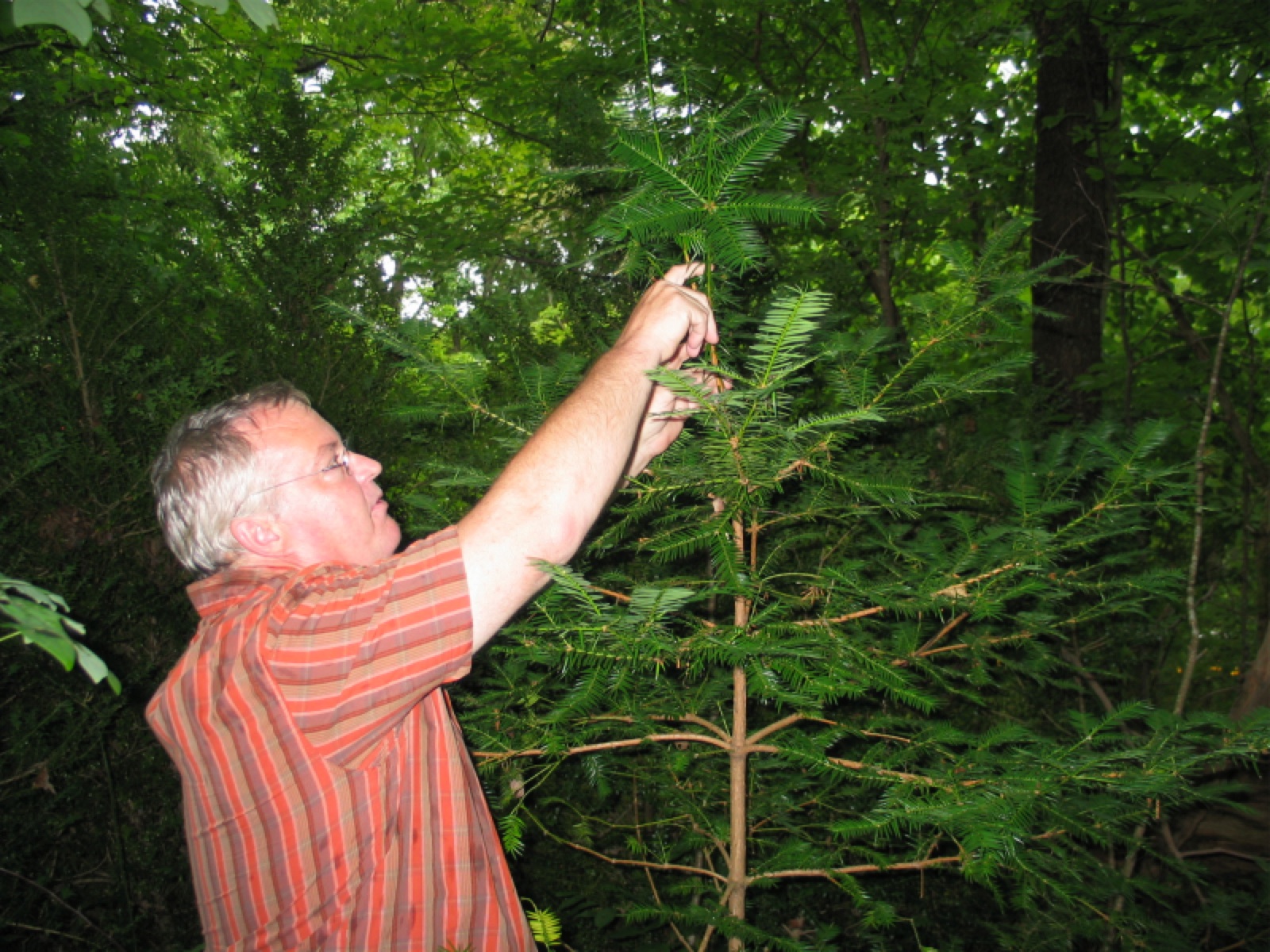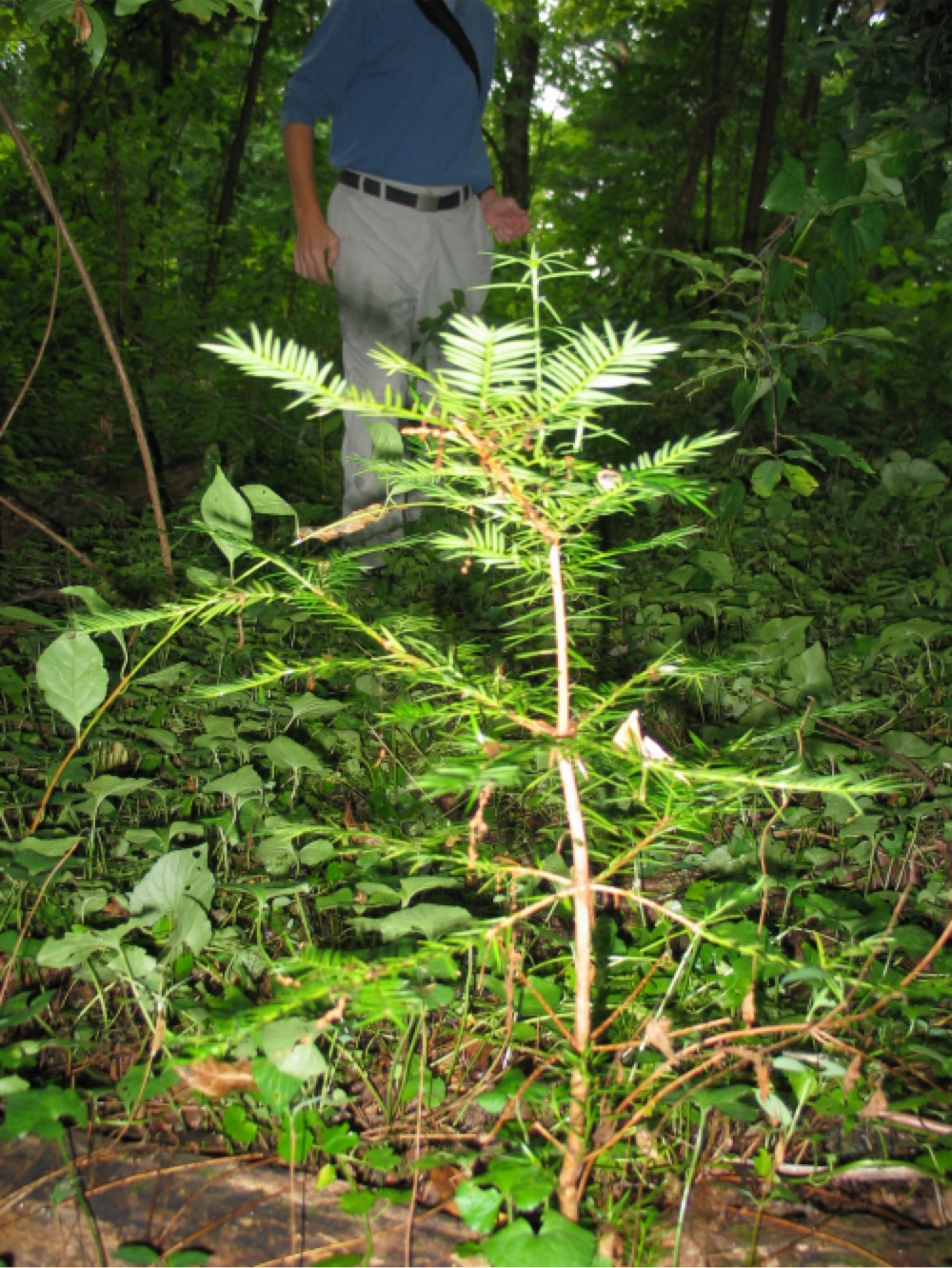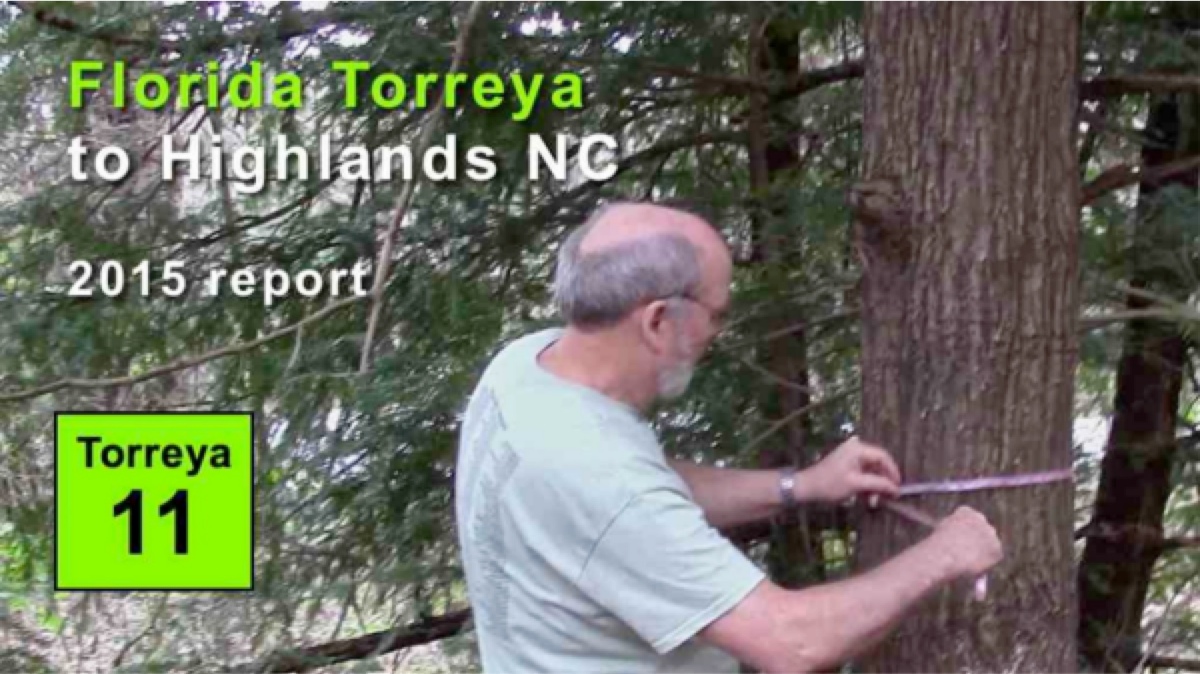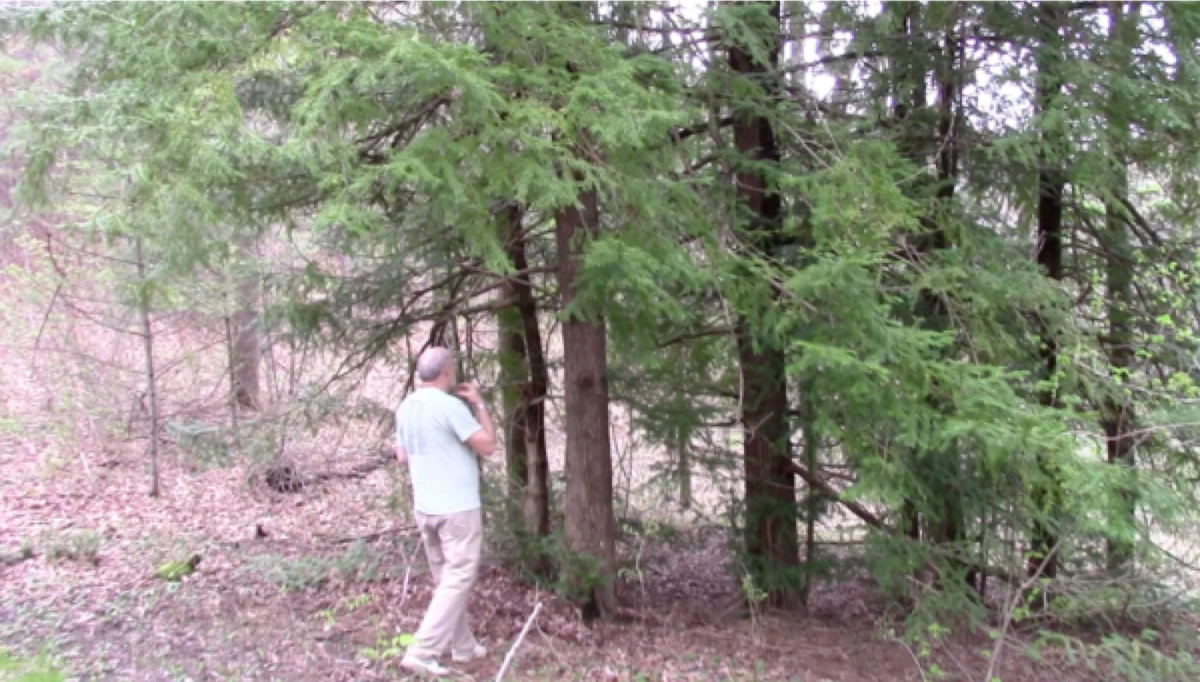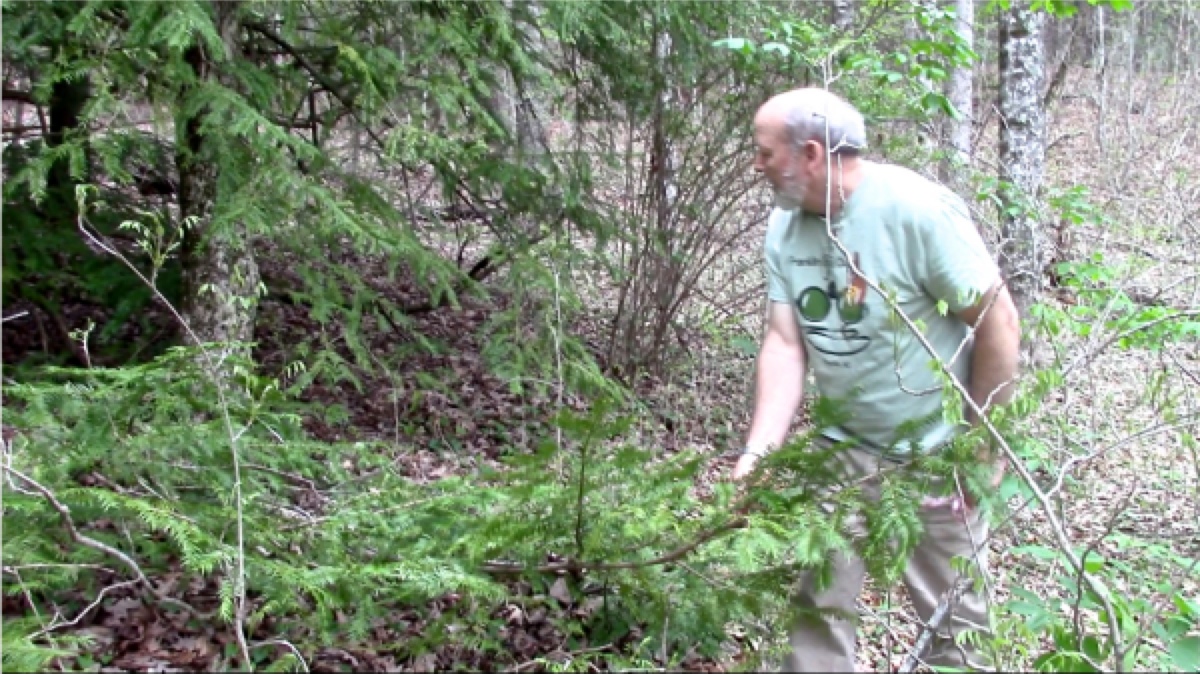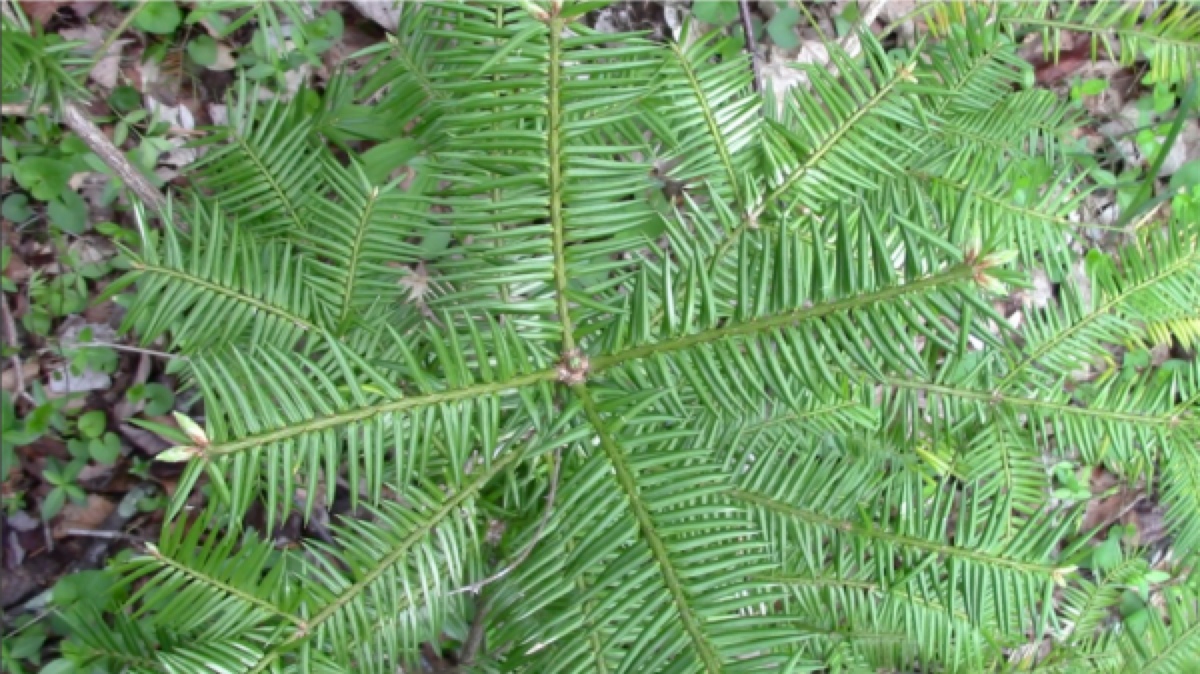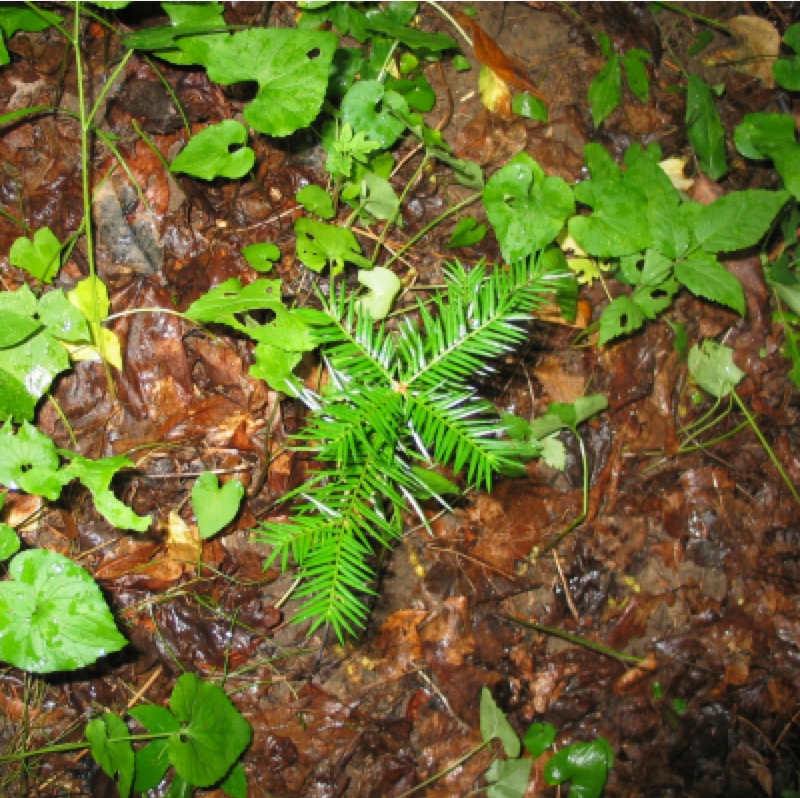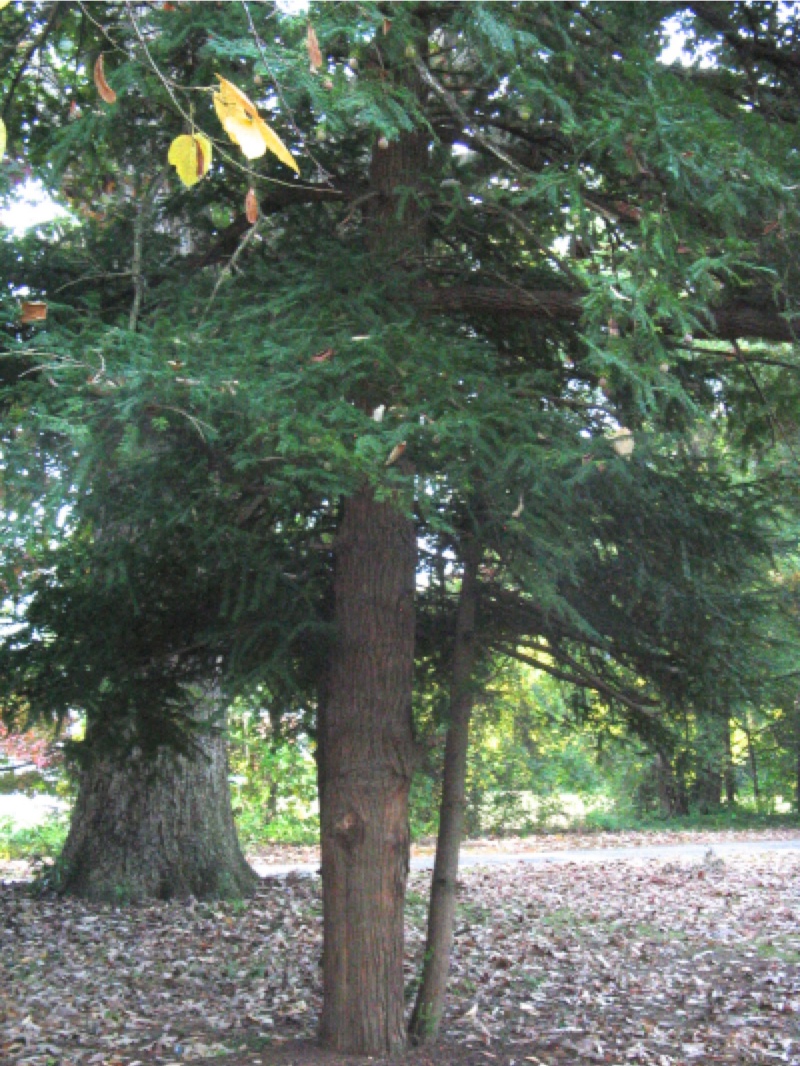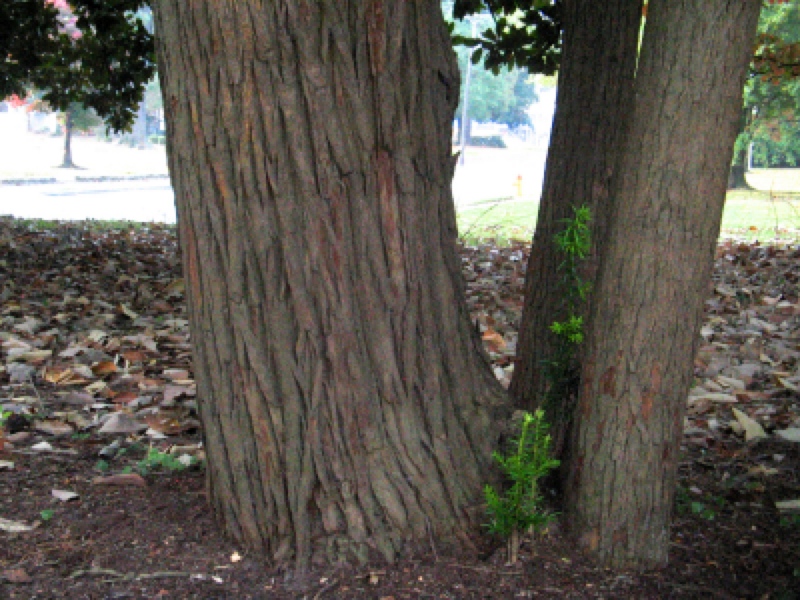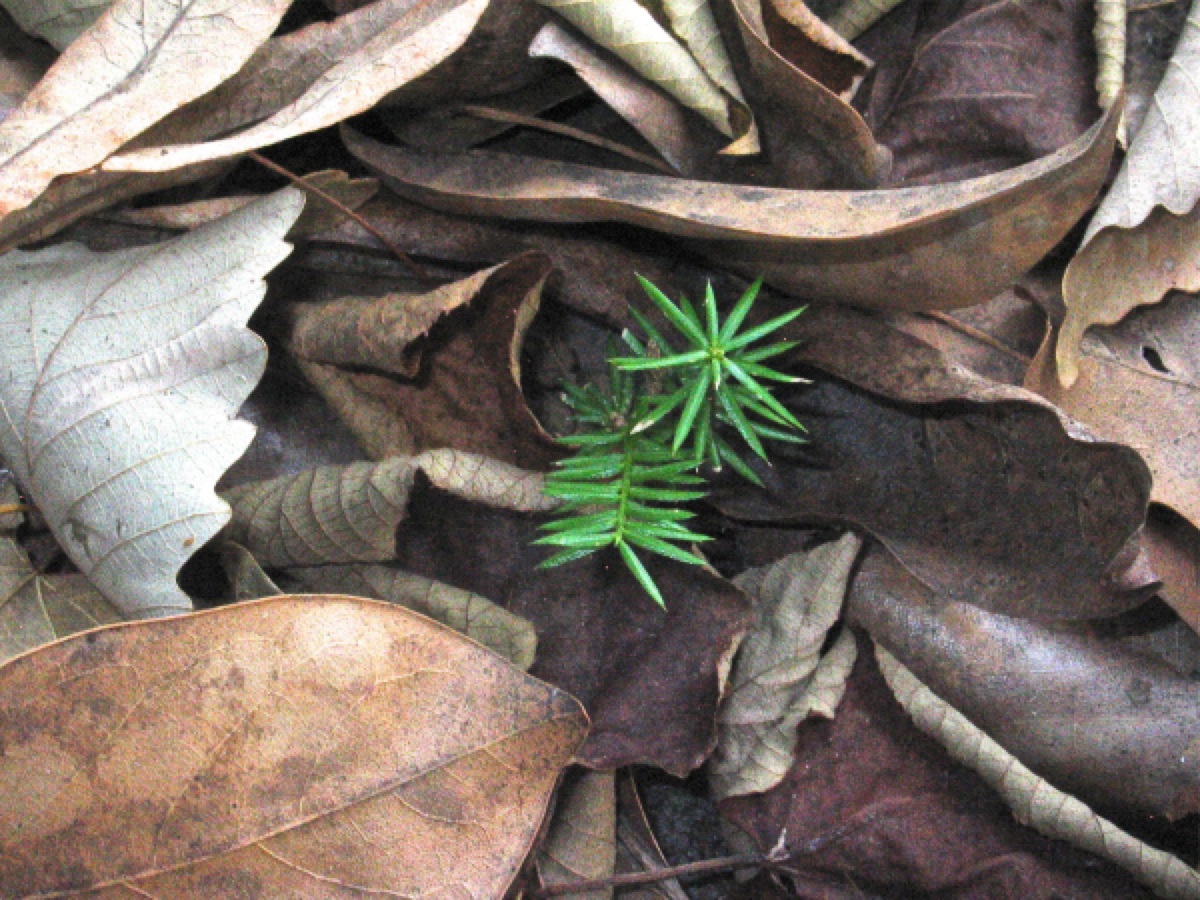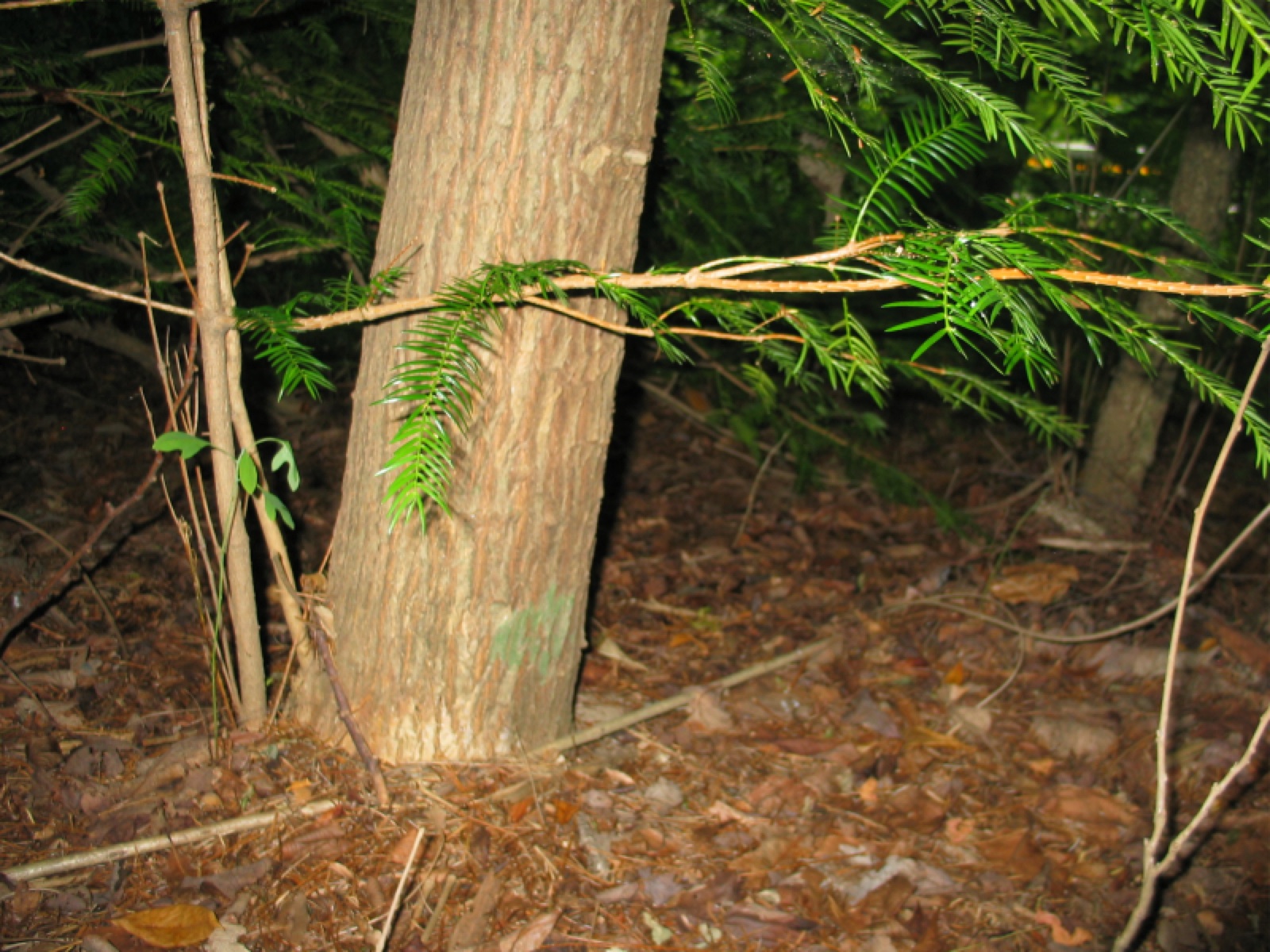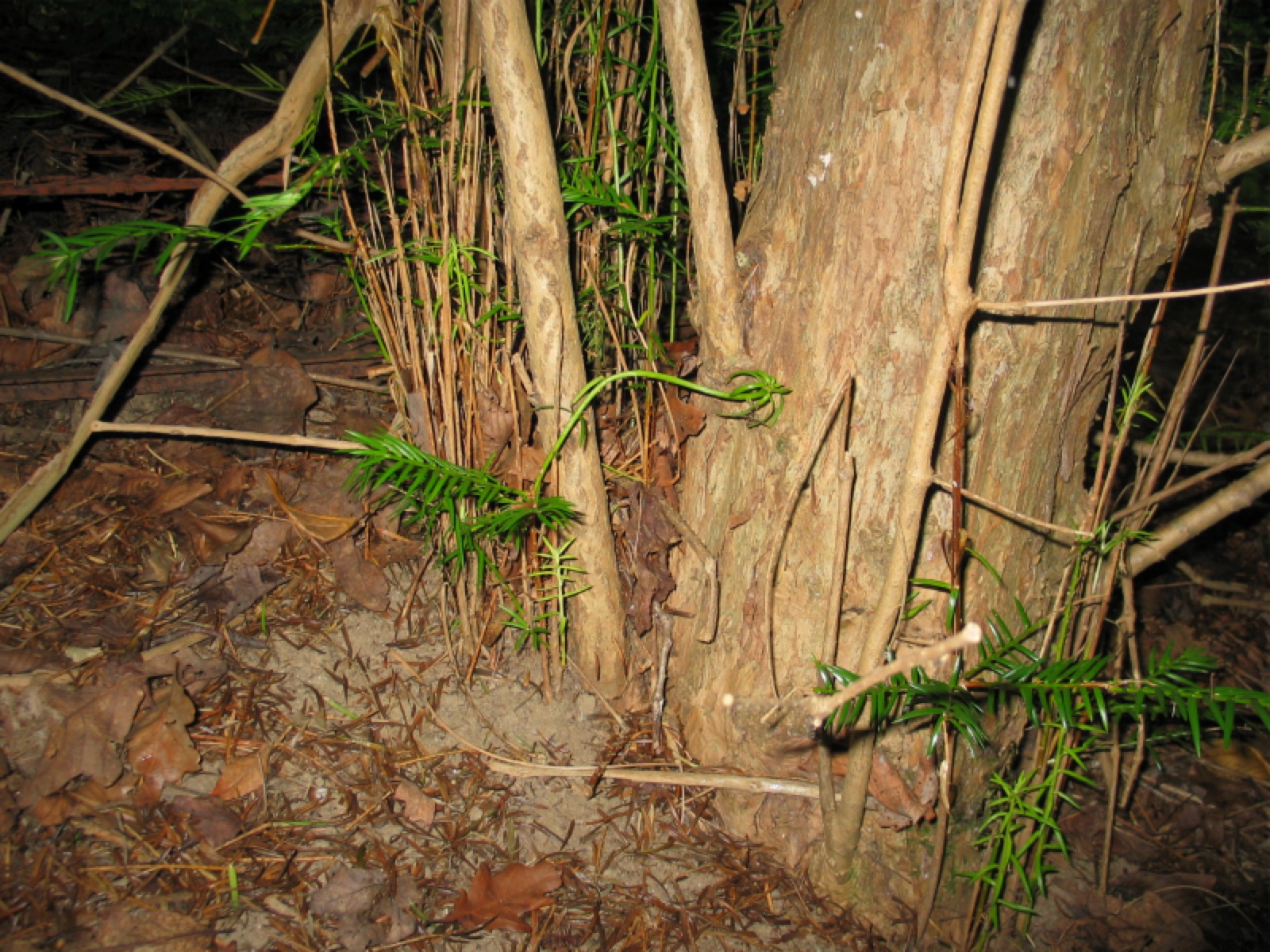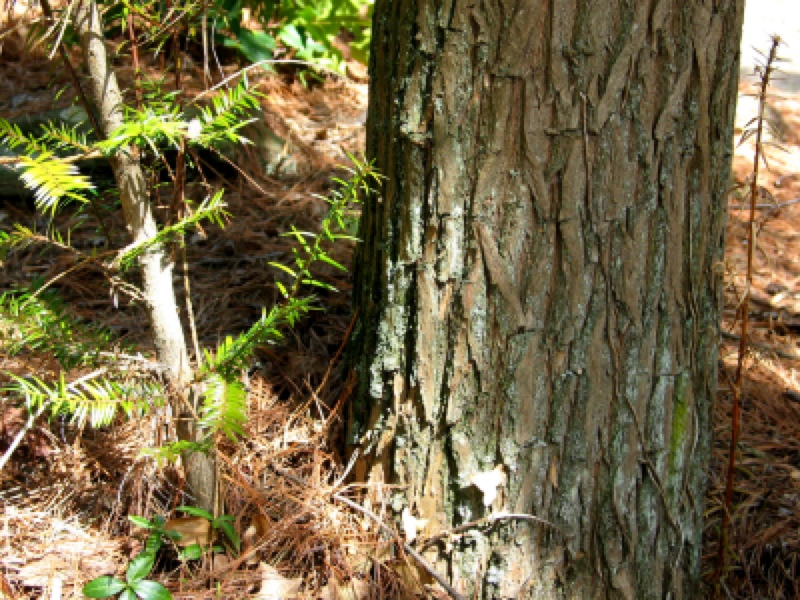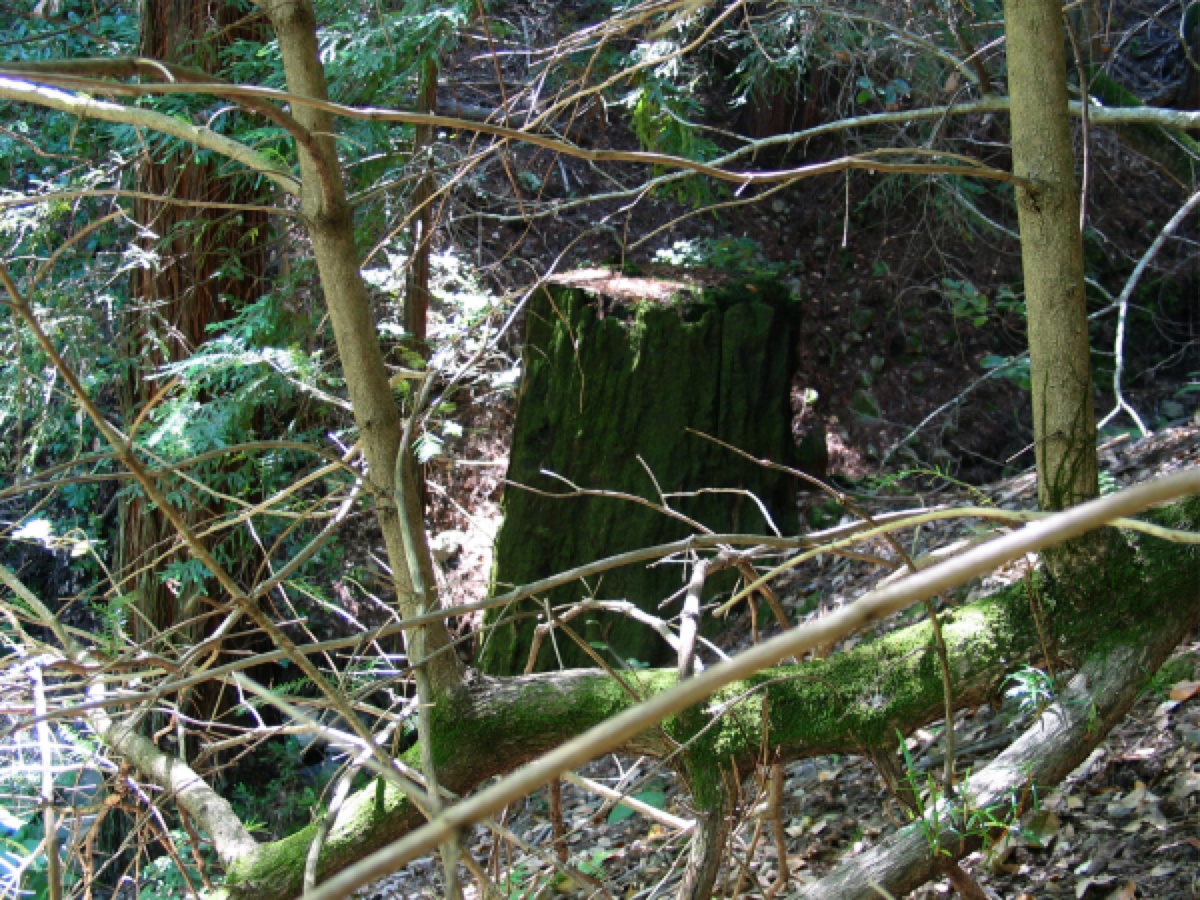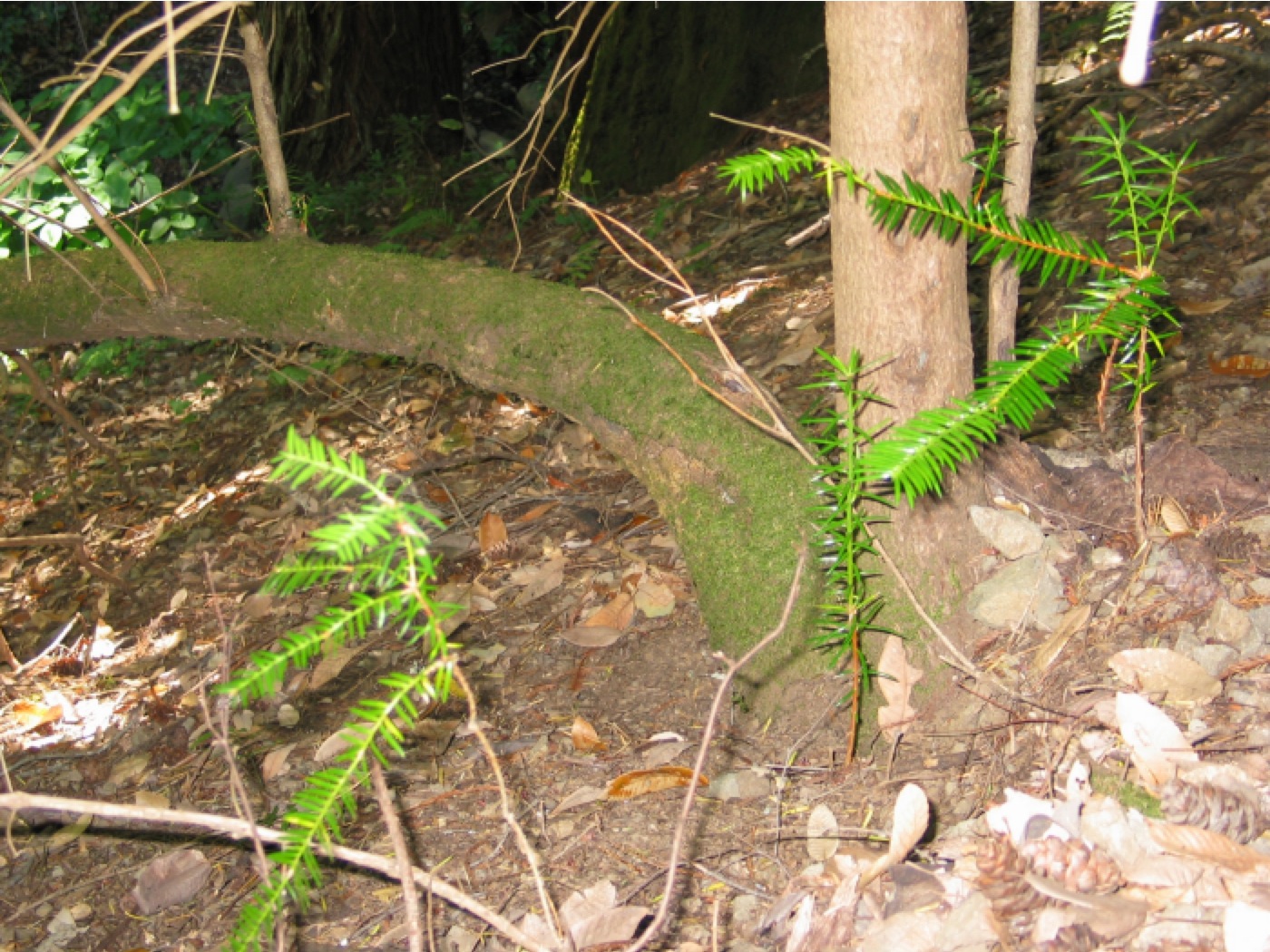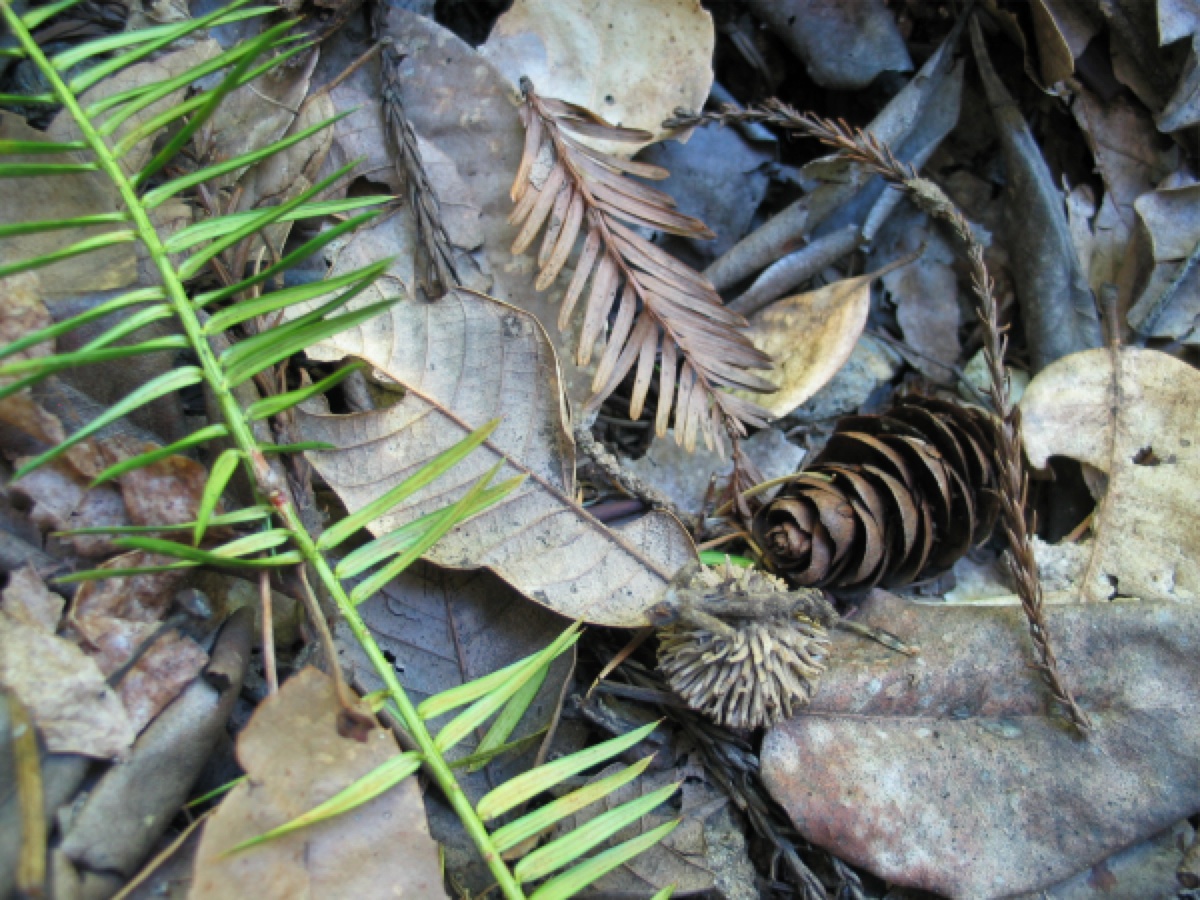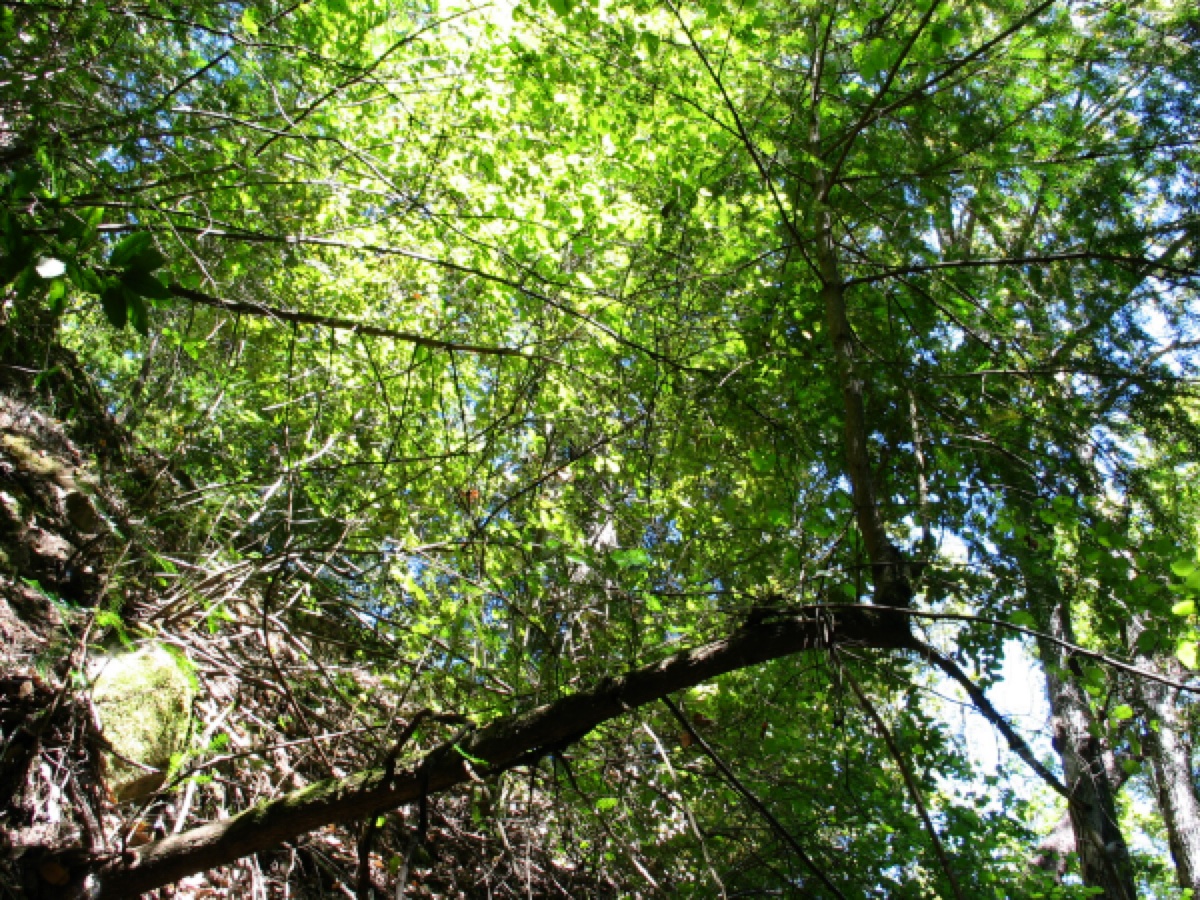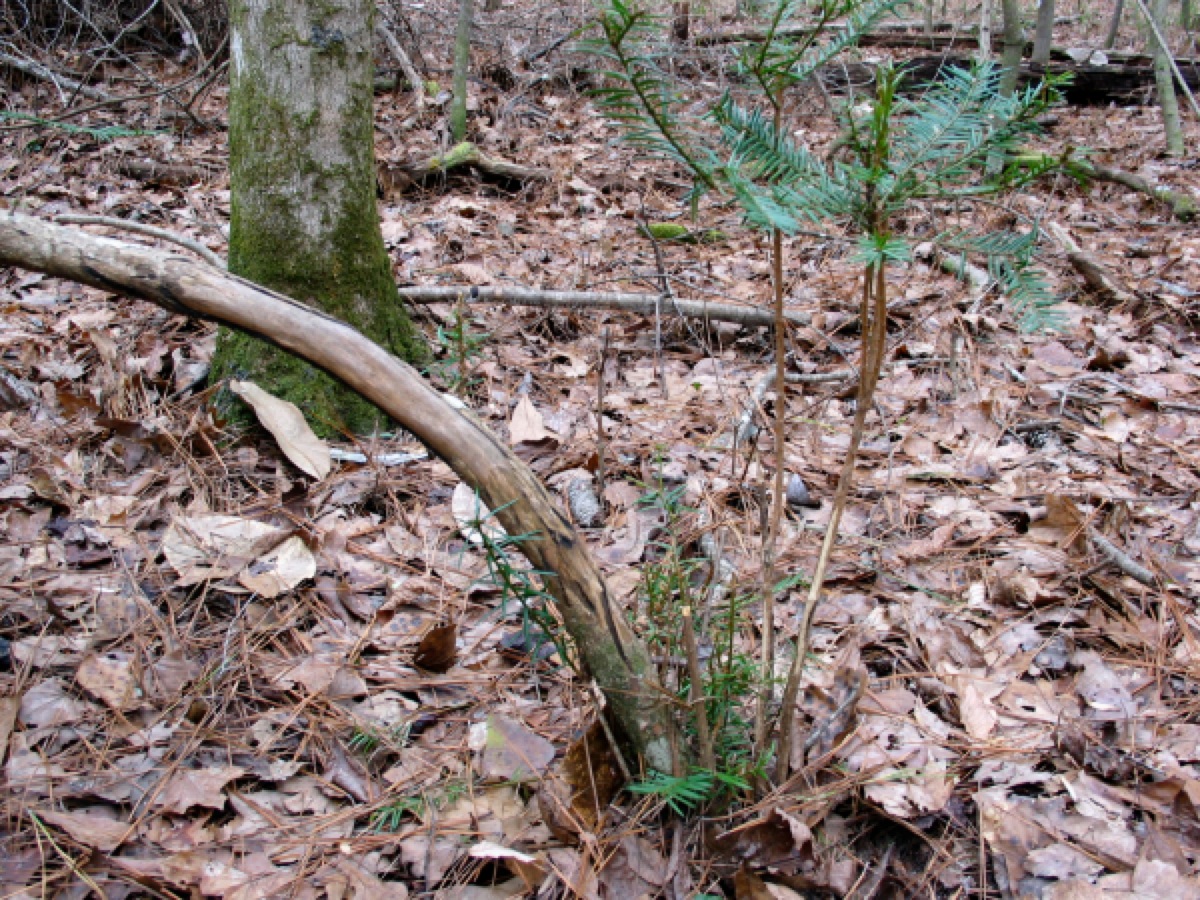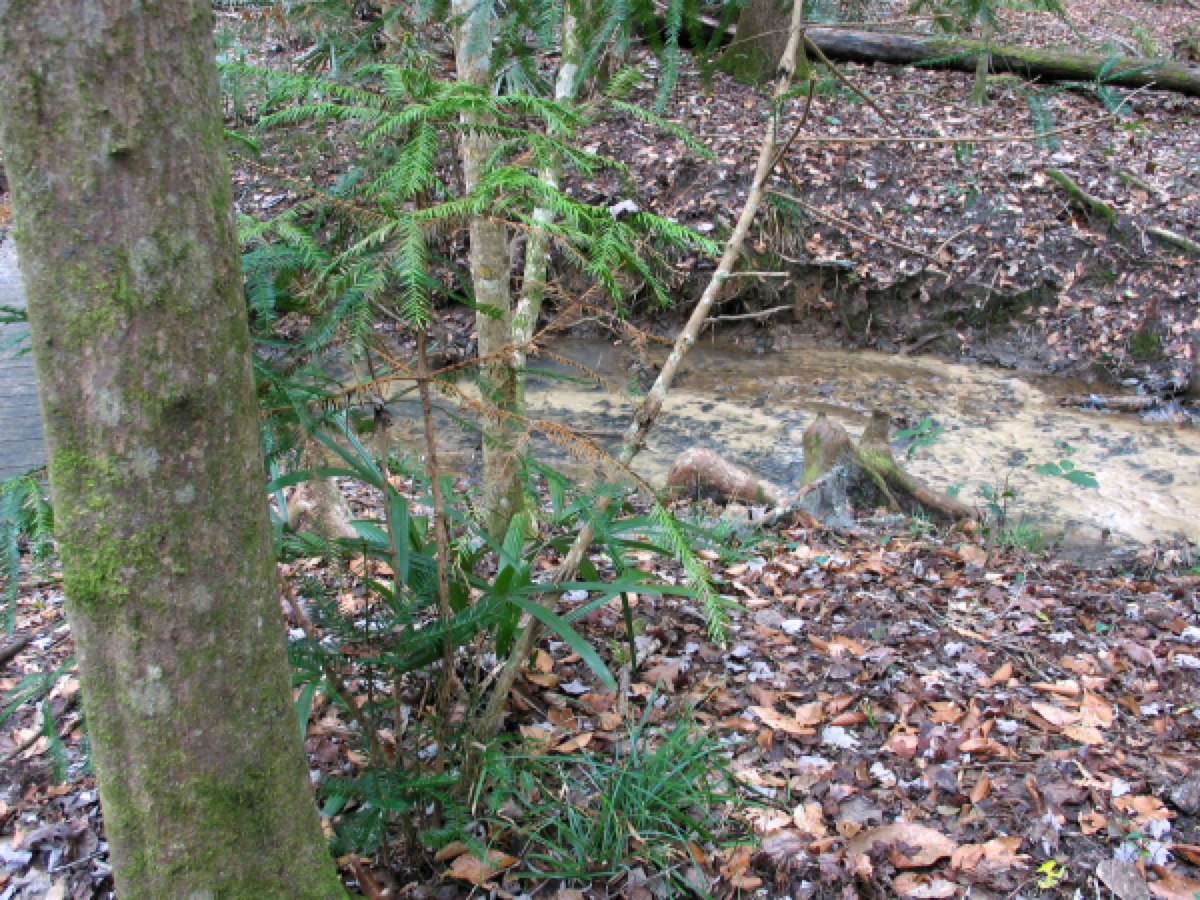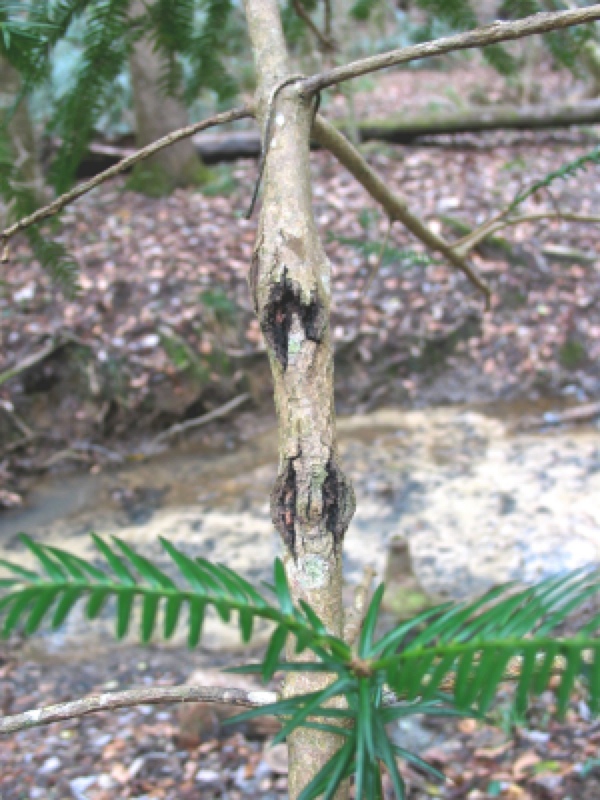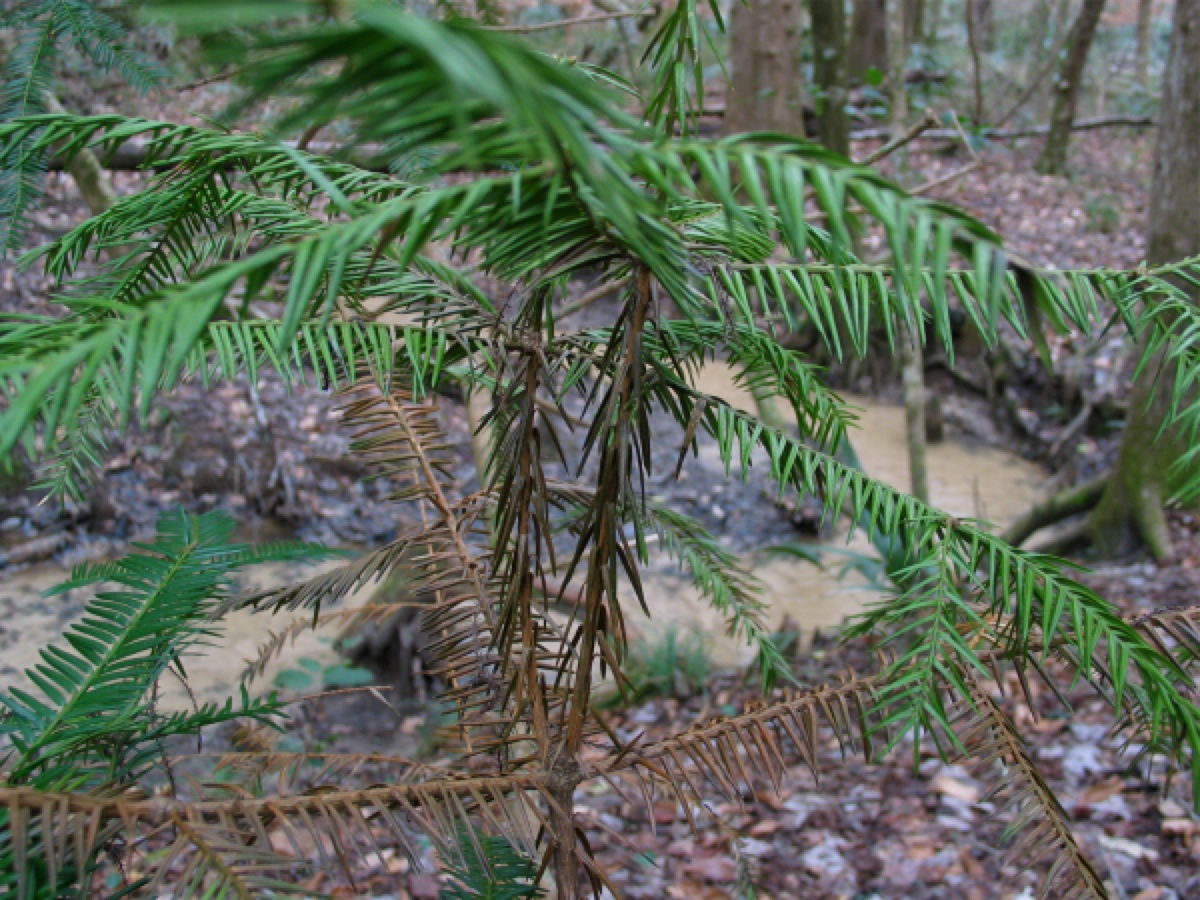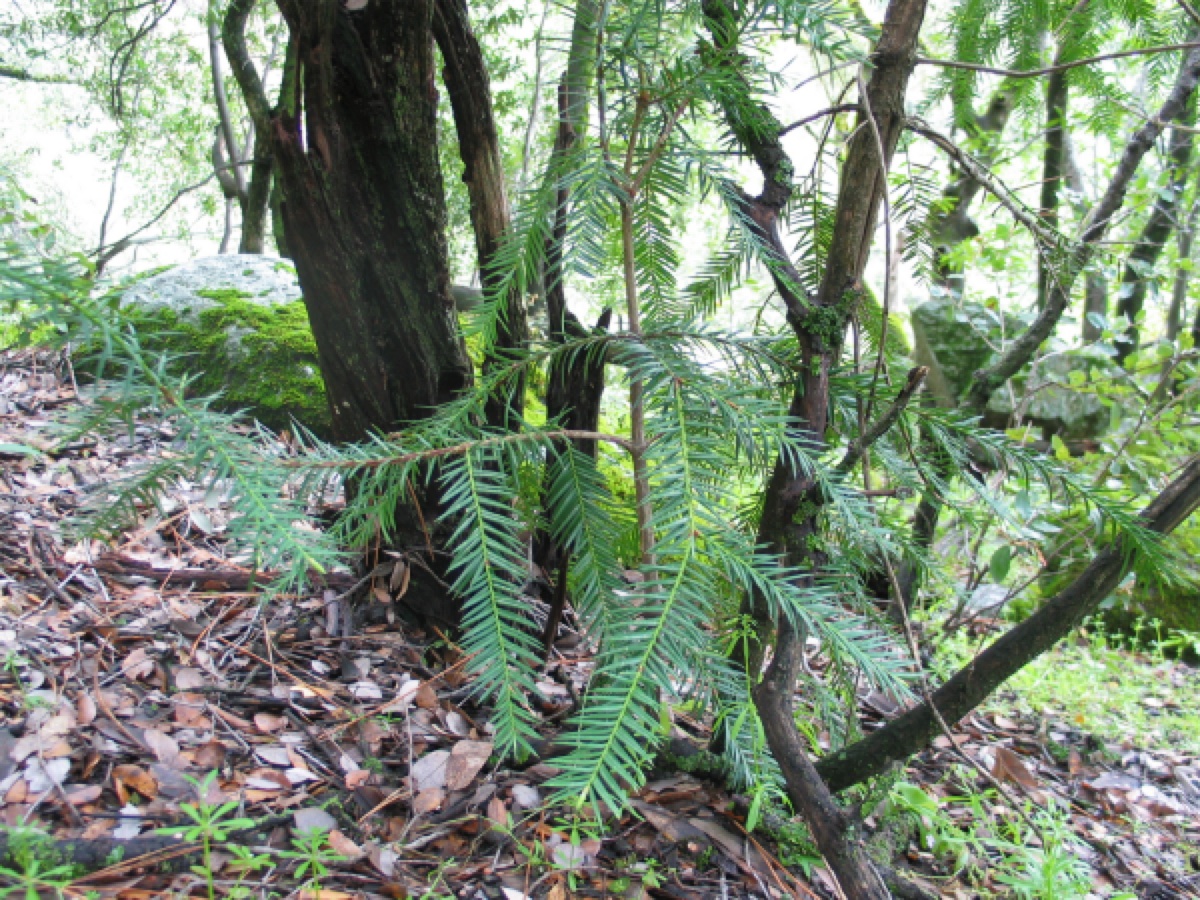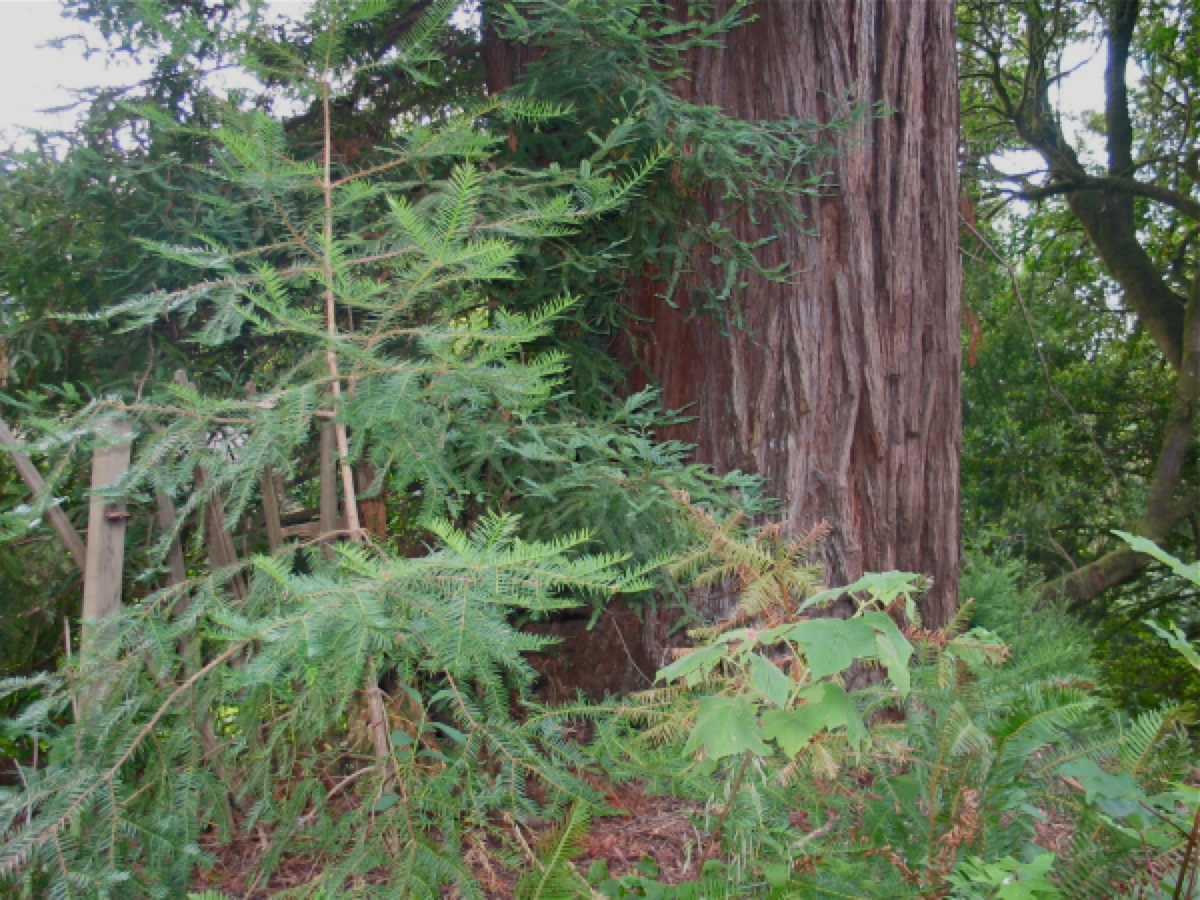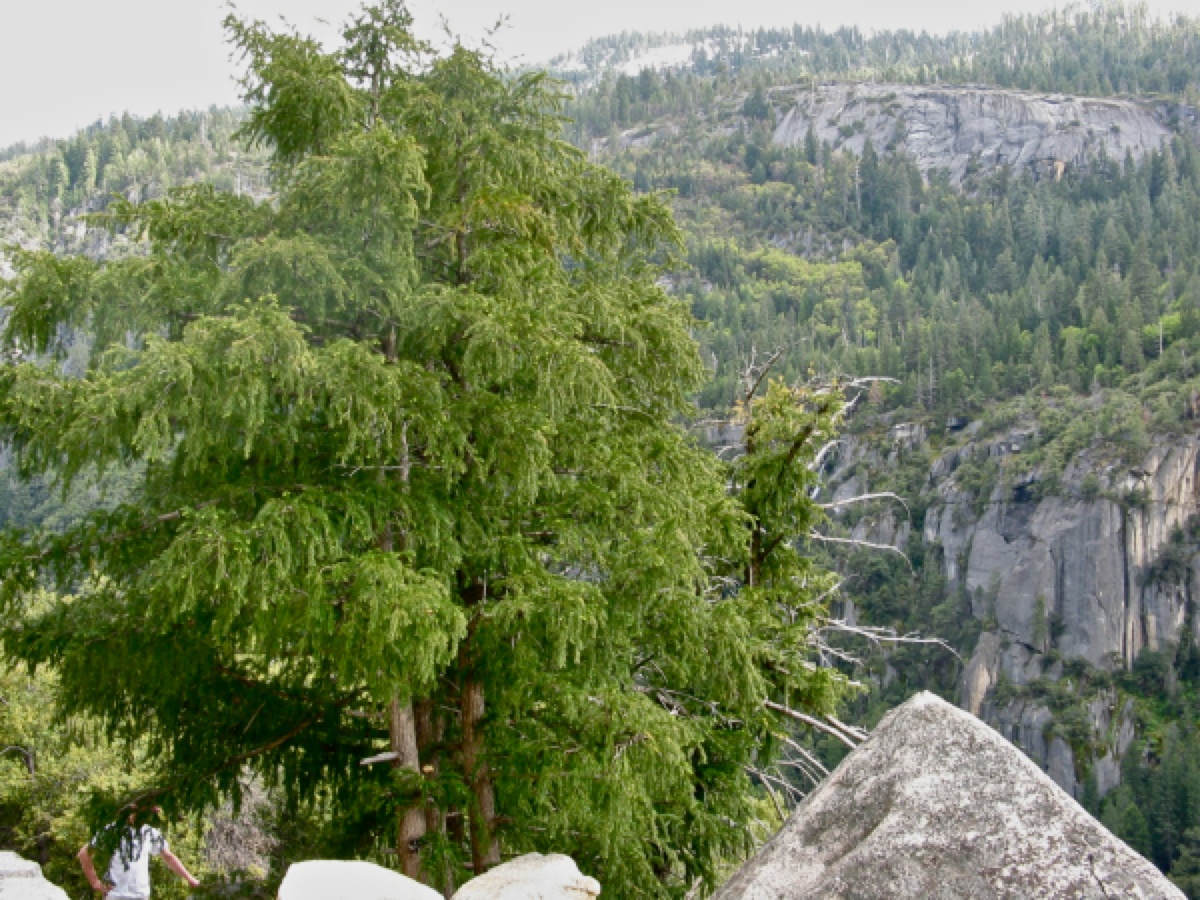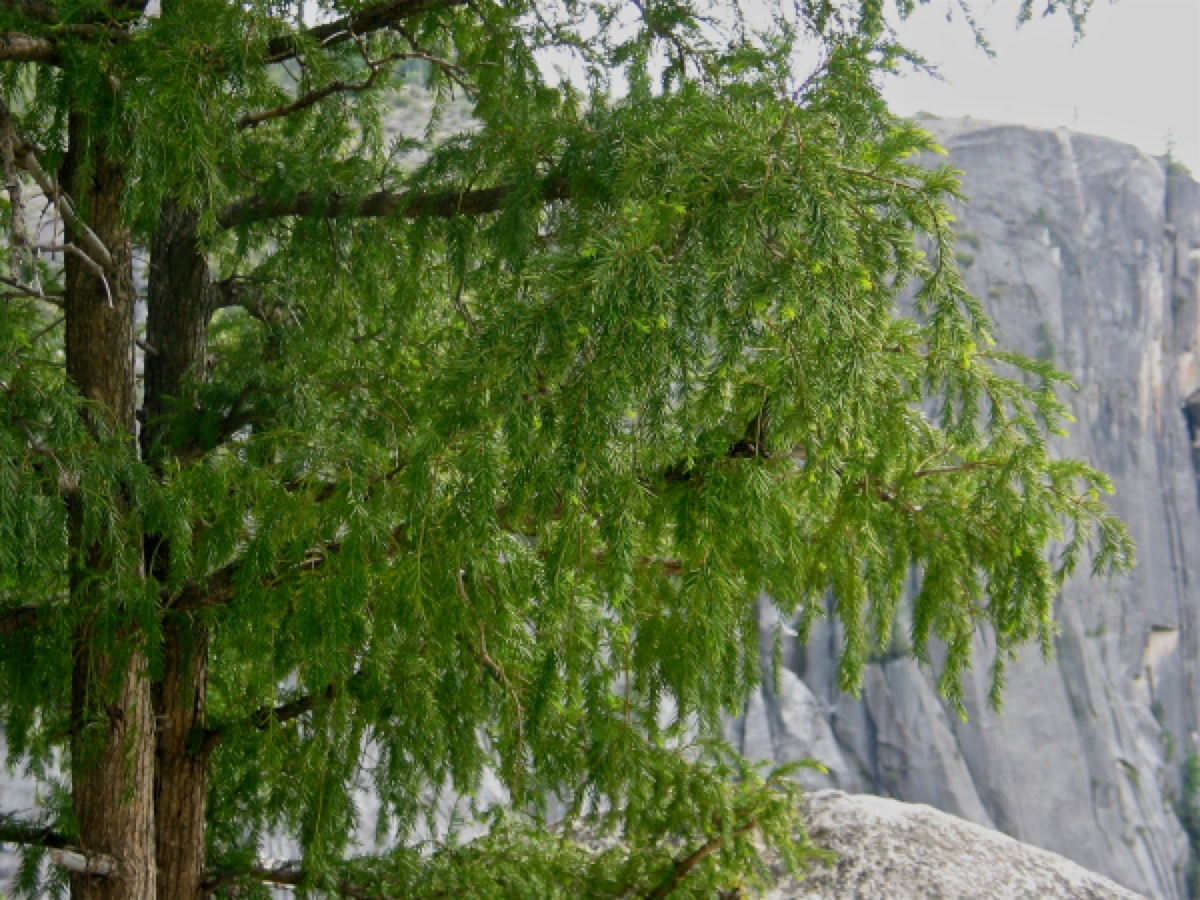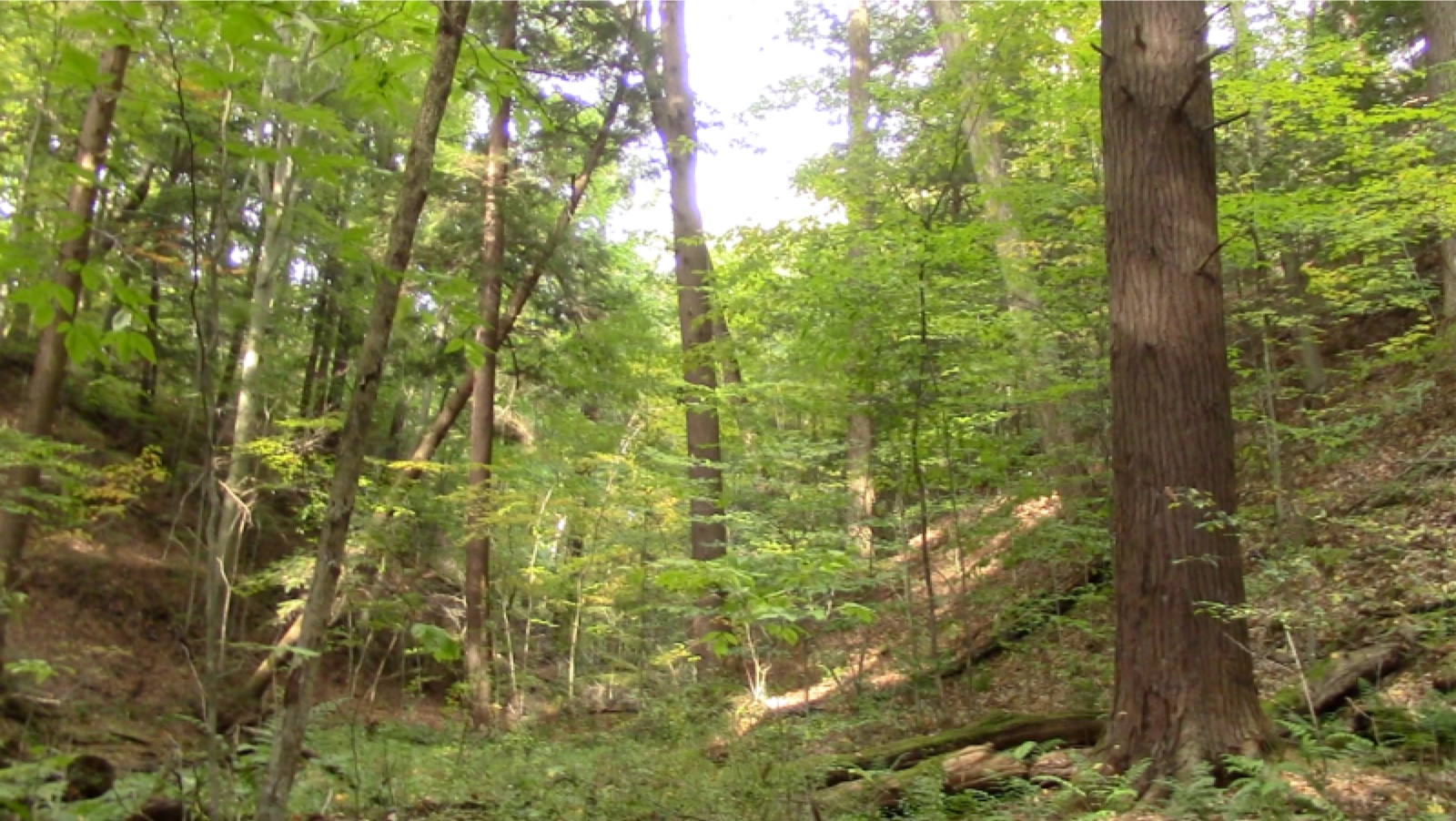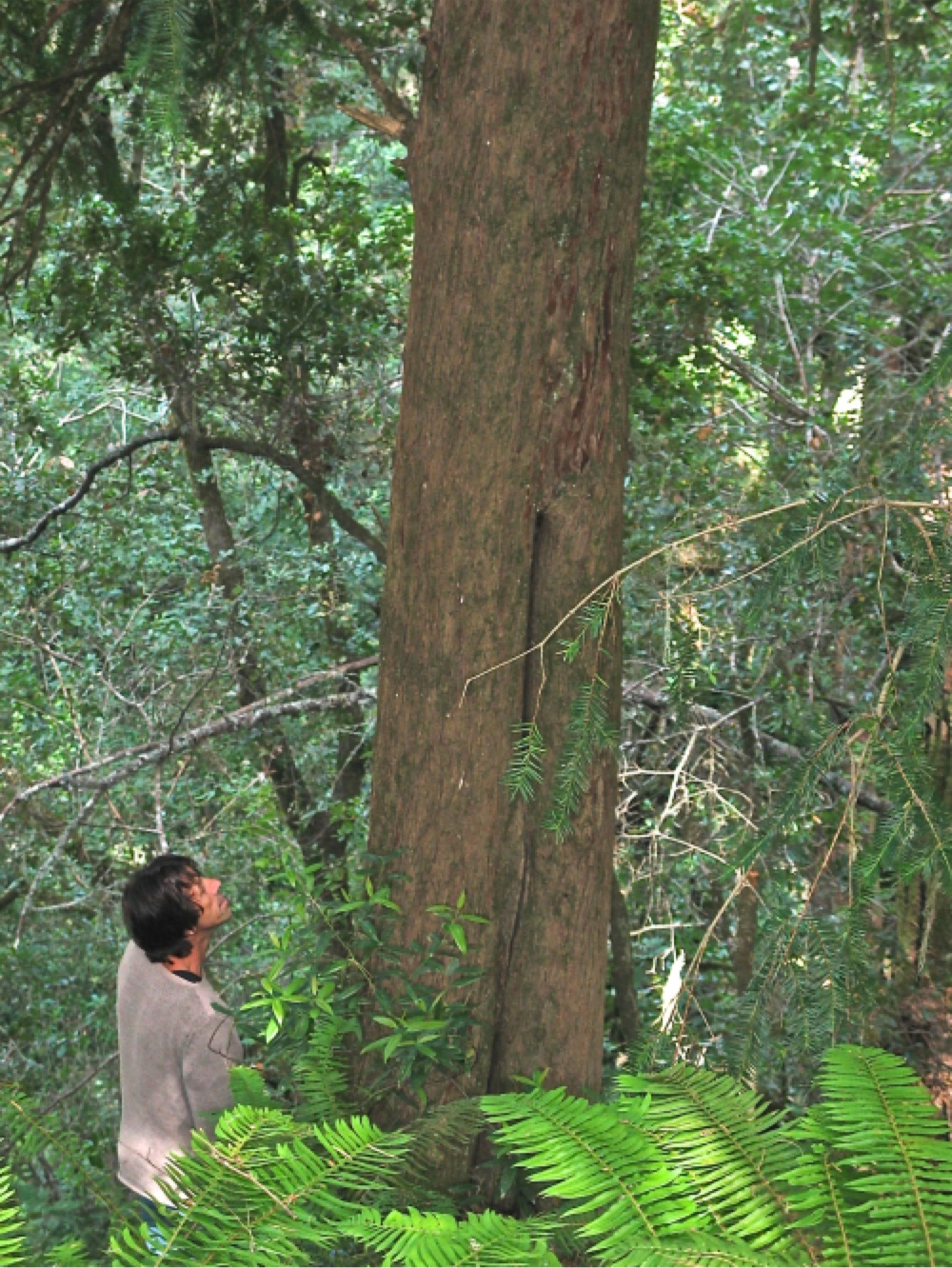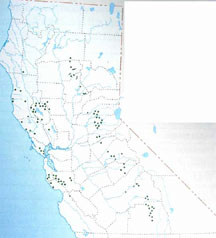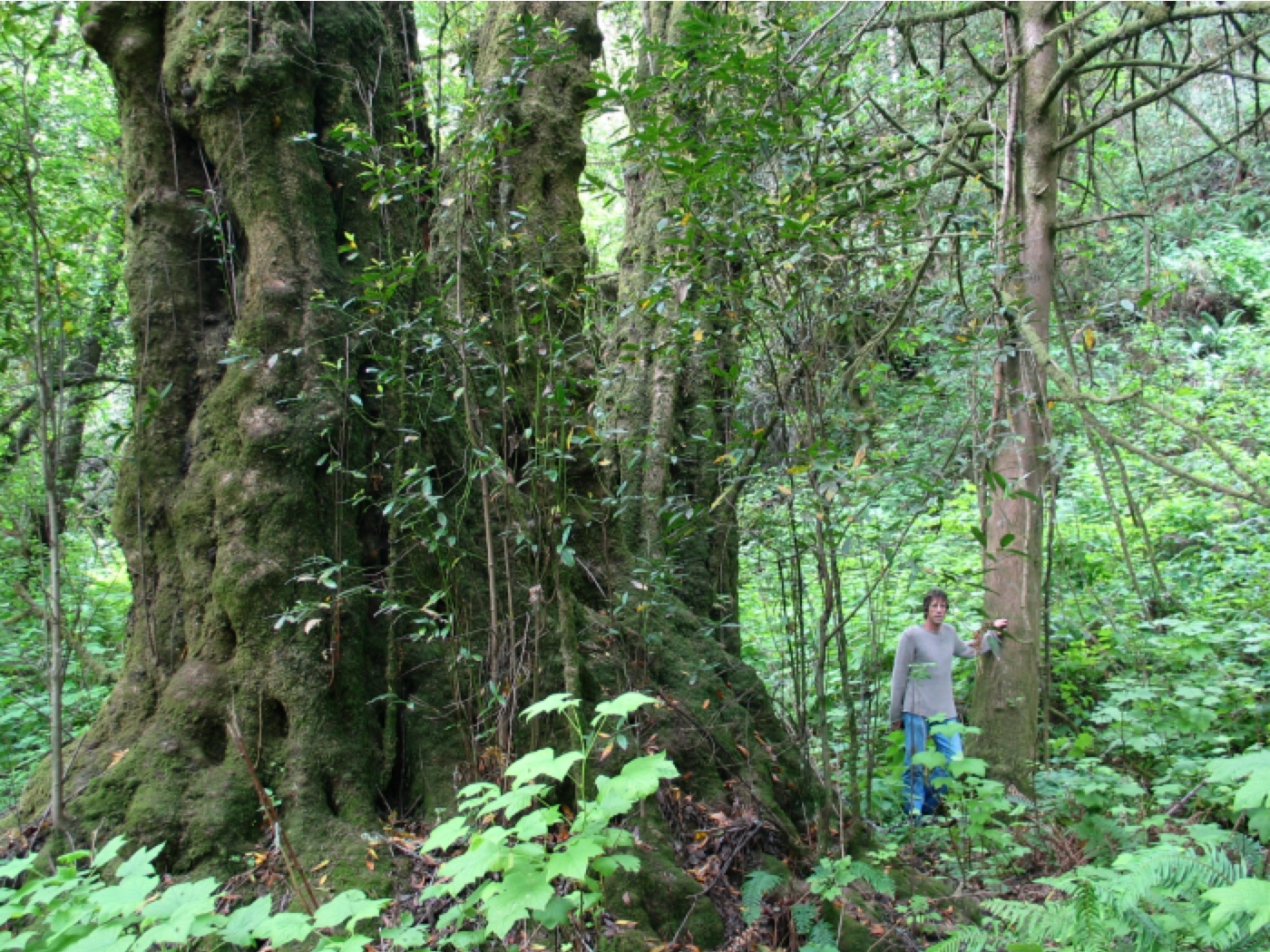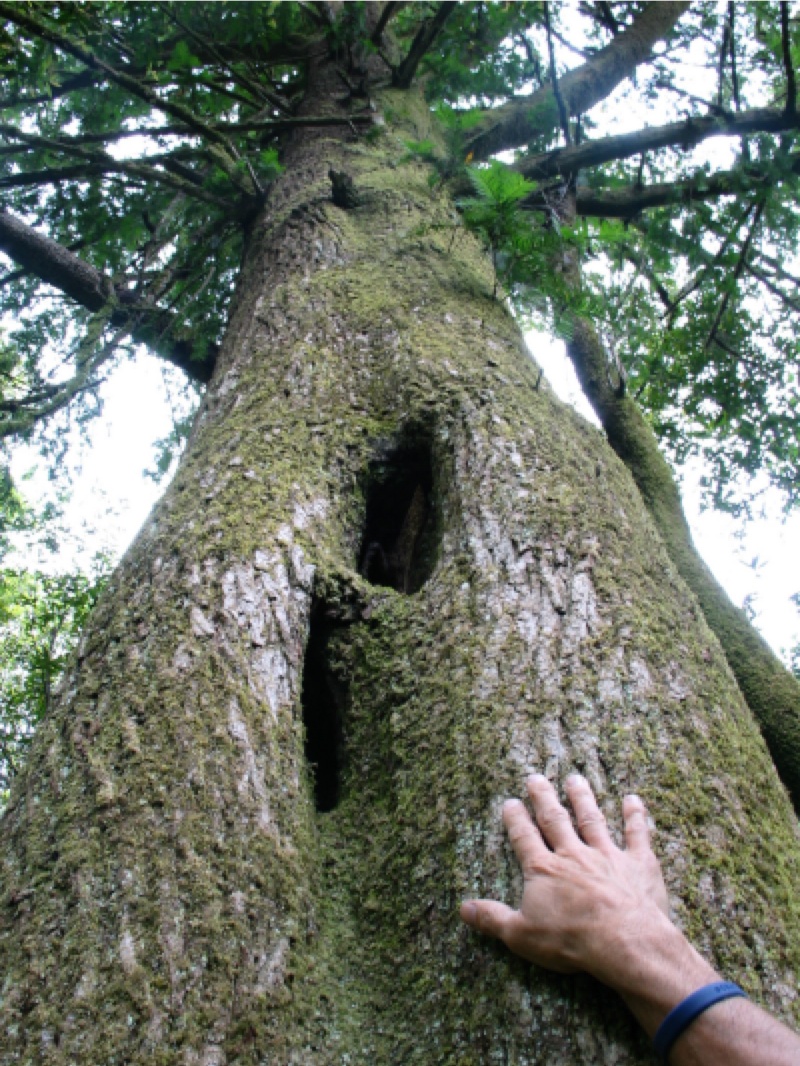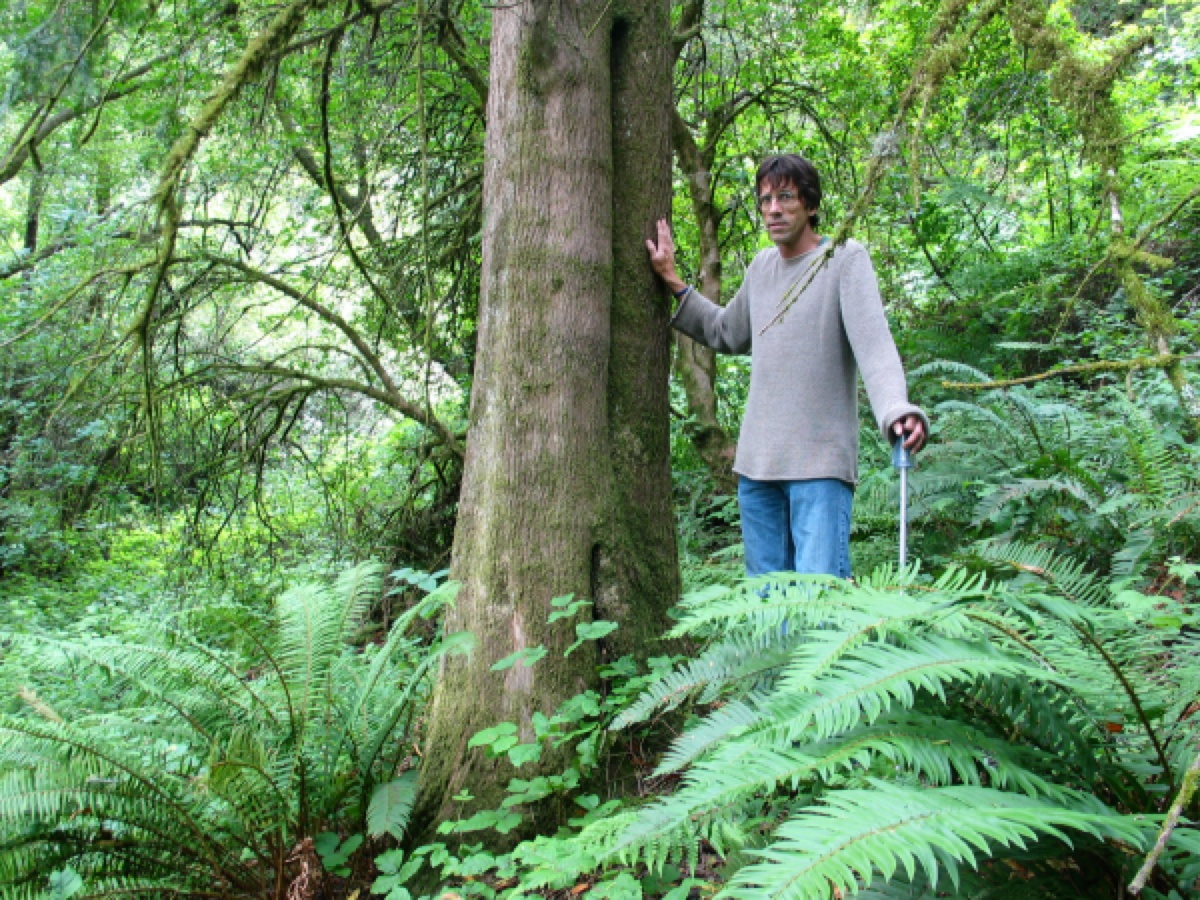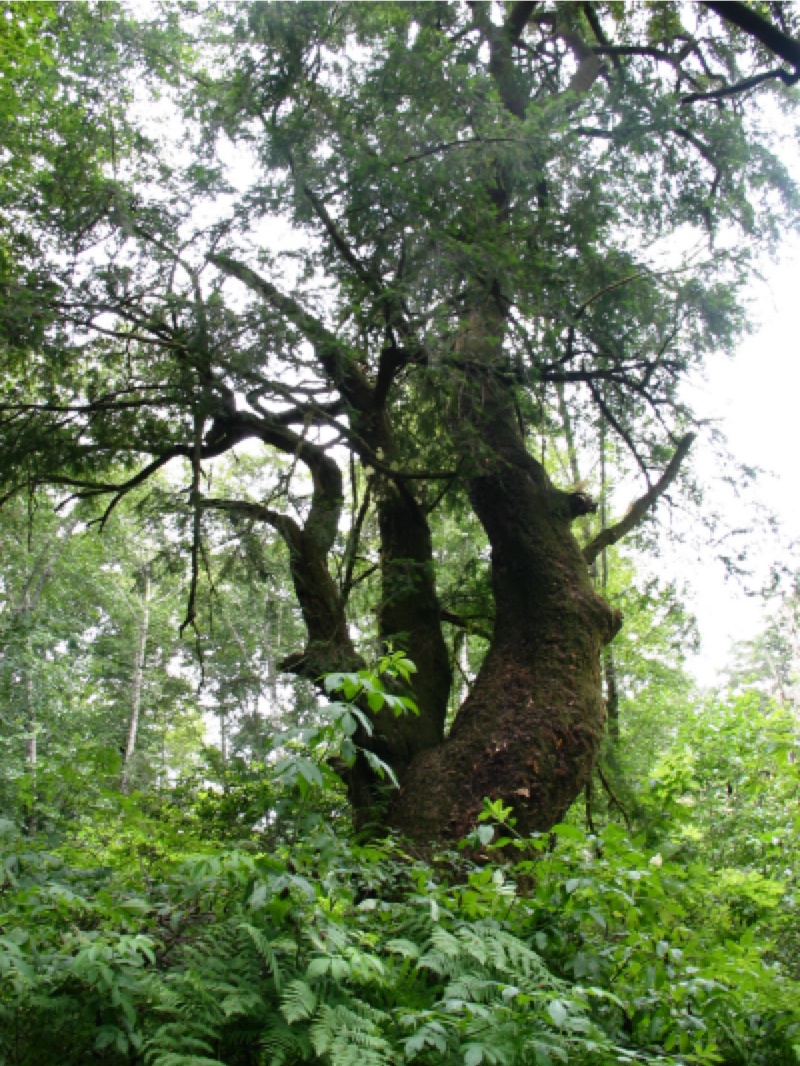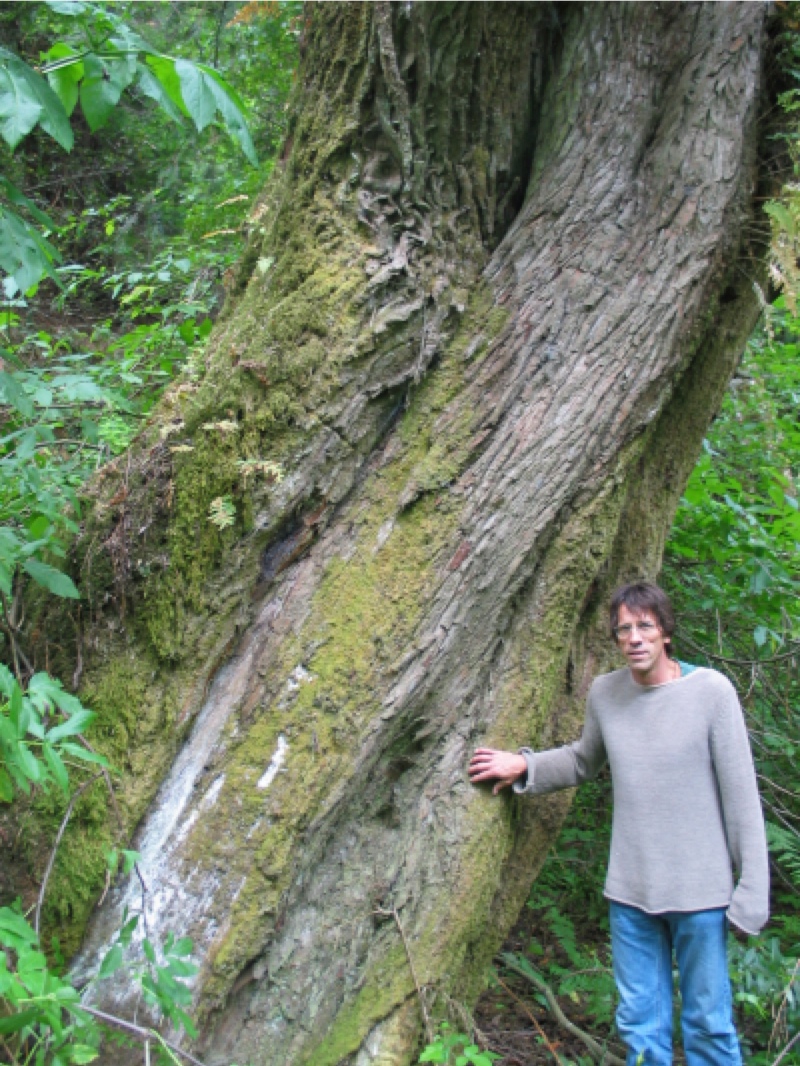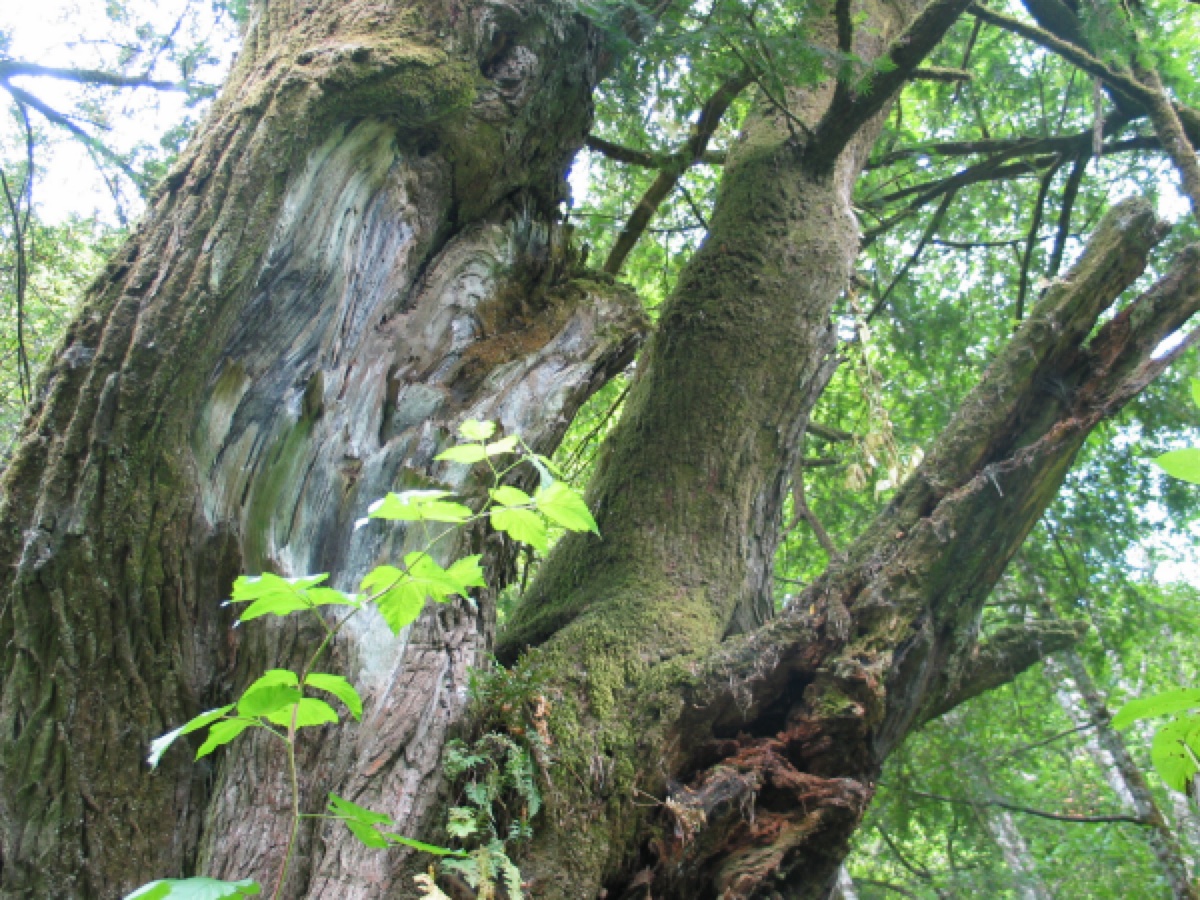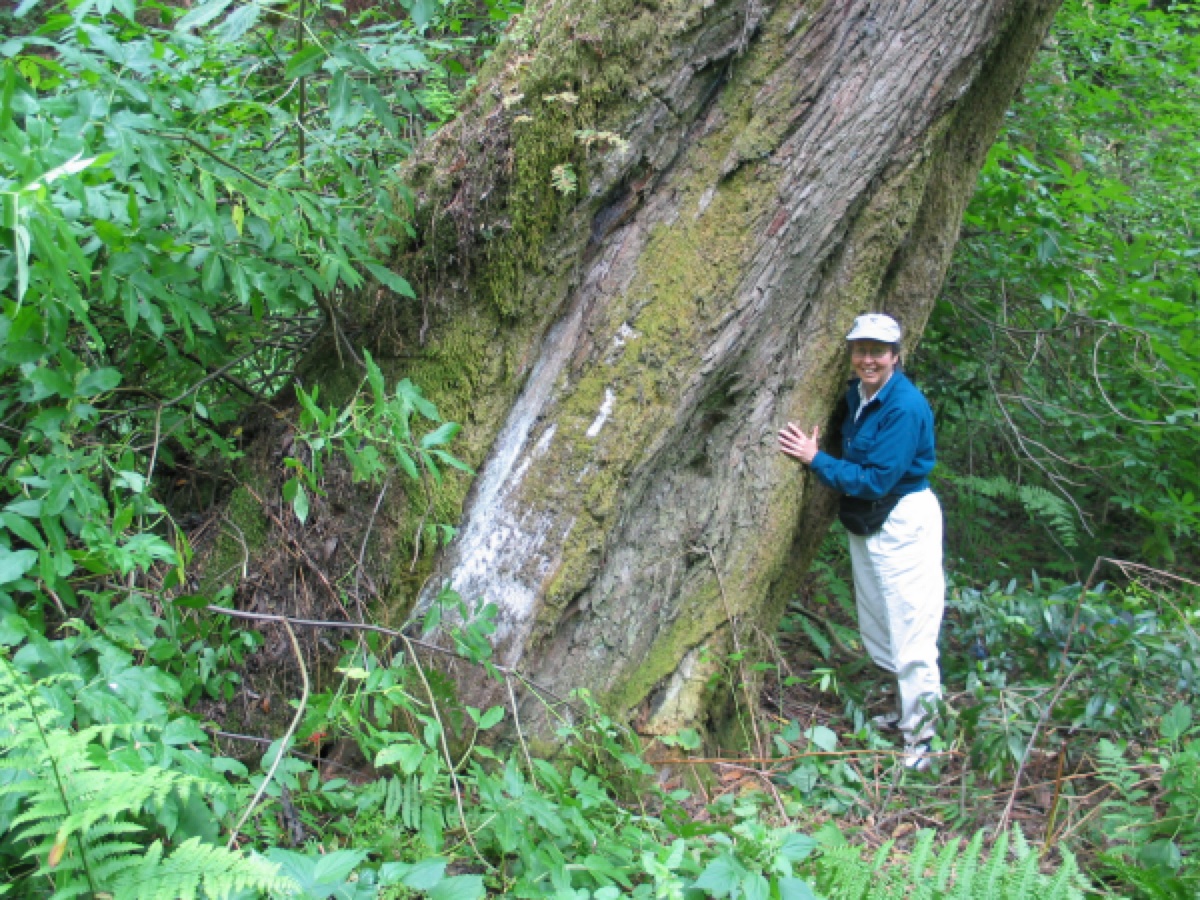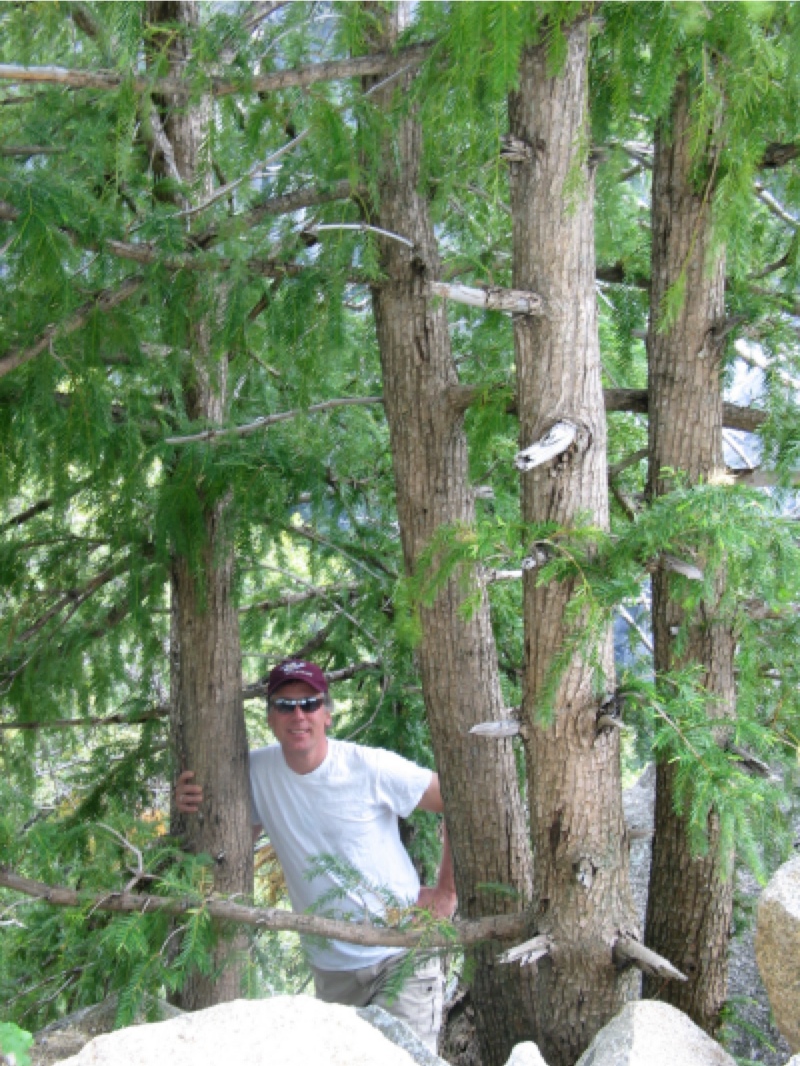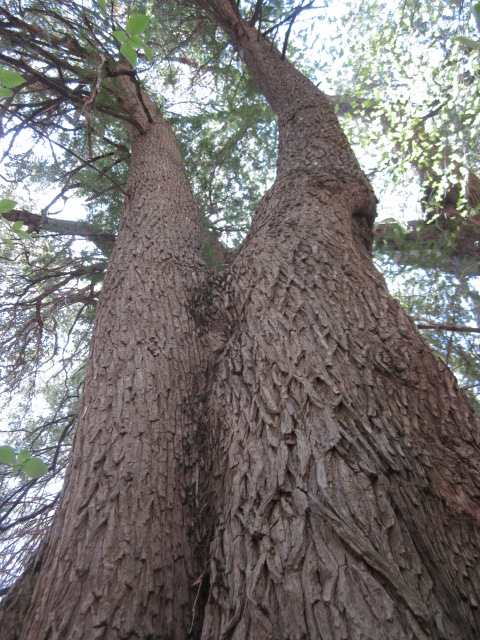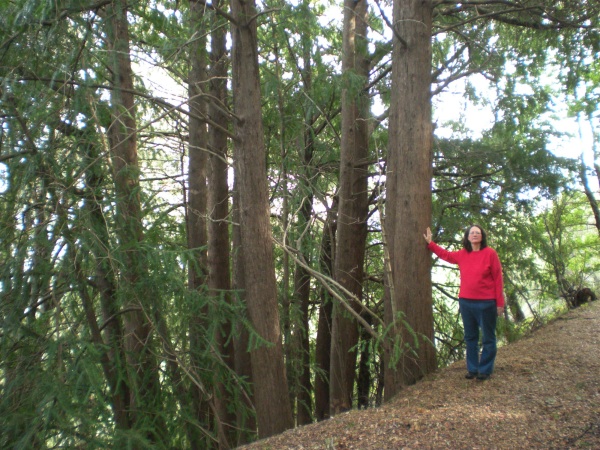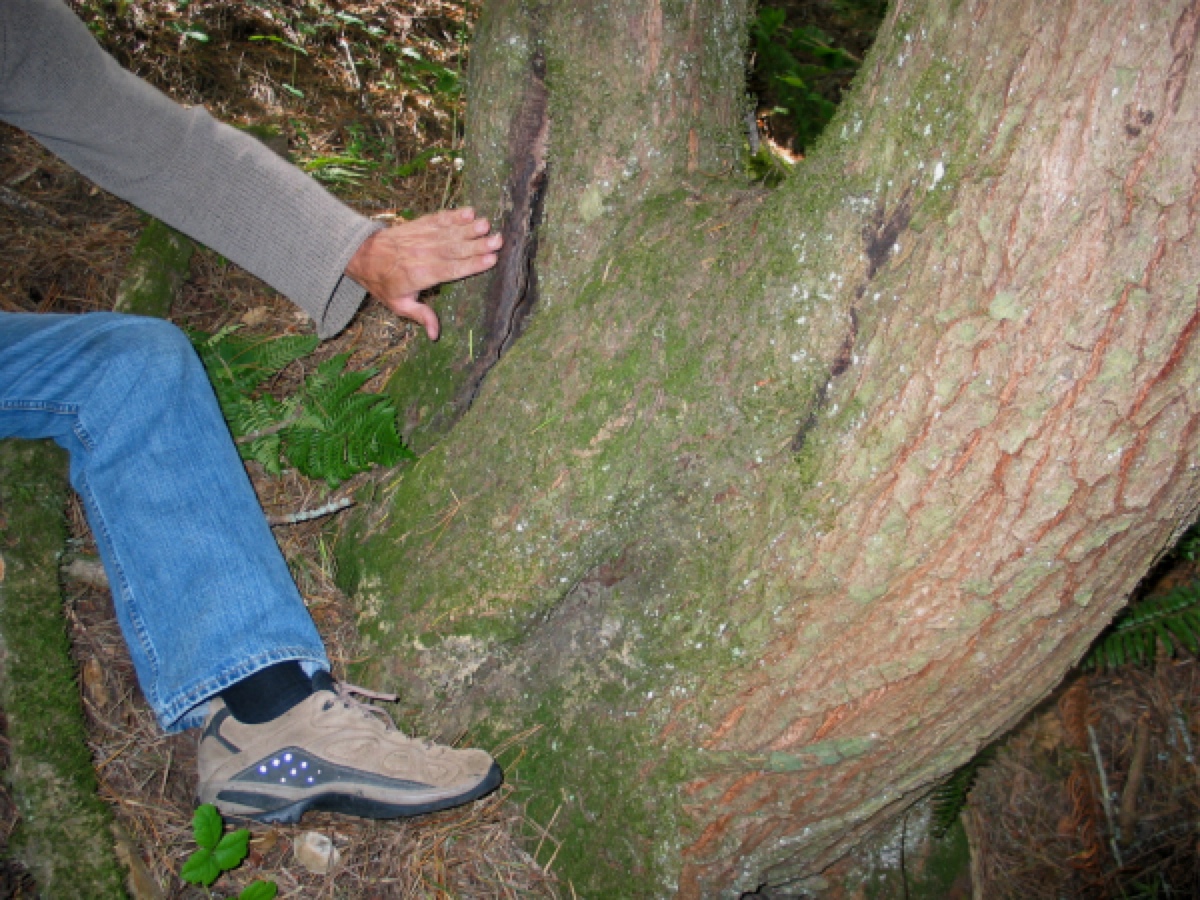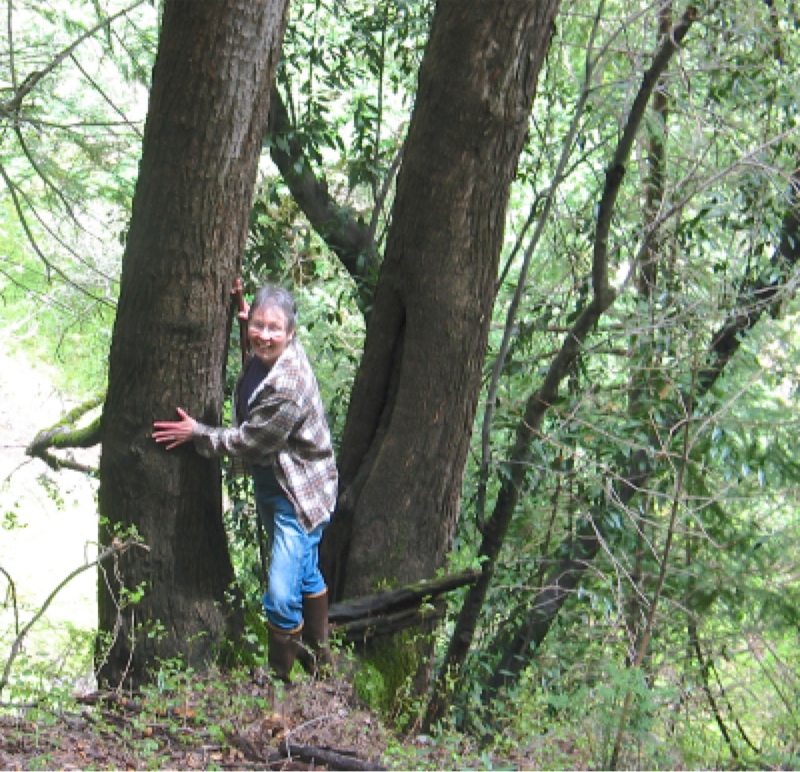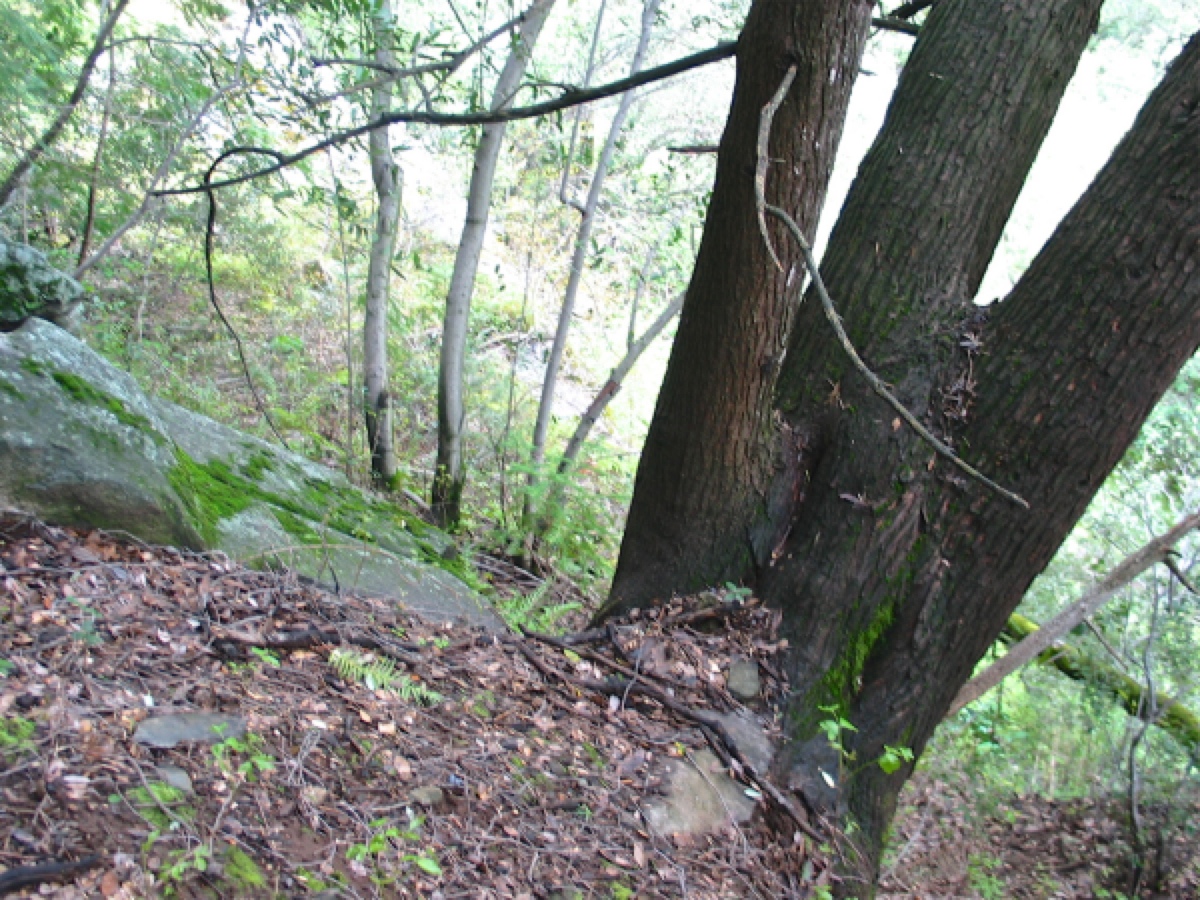|
2015 illustrated proposal by Connie Barlow, founder of Torreya Guardians
(nearly all photos by Barlow)
ABOVE: current range (left); grove in Meadville PA (right) BELOW: Woolly adelgid invasion
BELOW LEFT: Paleoecologists regard the small "native" range in northern Florida as having served as a "peak glacial refuge" for temperate species during the height of the Ice Age.
BELOW RIGHT: The biggest living specimen is in Columbus GA, growing along the bank of the Chattahoochee River. This river would have been the N-S migration corridor during climate shifts. The river itself could have carried Torreya seeds rapidly southward during coolings, but returning to the southern Appalachians to keep pace with warmings would have required seed dispersal by animals (now, only squirrels).
Note: Pollen of Torreya is indistinguishable from Taxodium, Taxus, and Cupressus. Therefore, no pollen records used for constructing past forest assemblages can prove or disprove the northward existence of Torreya.
"It is associated with a remarkable and somewhat extensive group of northern mesophytic plants, and the conclusion is irresistible that Torreya is a northern plant of the most pronounced mesophytic tendencies, and to be associated with such forms as the beech-maple-hemlock forms of our northern woods, our most mesophytic type of association. Probably it never becomes a large tree, although farmers always cut the trees as soon as they become at all usable. Rarely were any found over 30 cm in diameter or more than 9 to 12 m high. It has remarkable capacity for vegetative reproduction, almost equaling the redwood in this respect. Many suckers issue from cut stumps, and even from fallen trunks; even rotten stumps show vigorous suckers, and it seems to be as tenacious of life as the poplar. Staminate trees appear to be the more numerous; however, when in blossom they are far more conspicuous than are the pistillate trees, and the conclusion as to proportion may not hold."
Hemlock leaves
Torreya leaves
Both conifers have a leaf structure superbly adapted for intercepting minimal light in over-shaded forests.
Tsuga canadensis (left) releases small winged seeds from standard conifer cones.
Torreya taxifolia (below) is a member of the yew family, Taxaceae, and bears large, flesh-covered seeds. Botanists regard very large seeds as an indicator that the species is adapted to easily establish beneath very dark canopies.
Below left: Mature seeds hang on the Clinton NC Torreya tree, October 2013. Visit an in-depth photo-essay of the seed-producing Torreyas in Clinton and nearby Mt. Olive NC.
Torreya taxifolia naturalized in North Carolina
LEFT: The oldest, "wildest" Torreya taxifolia grove was planted during the 1920s near Highlands, NC. Original specimens are in photo left. Just like hemlock groves, they produce dense shade. And just like hemlocks, North America's eastern species of Torreya conifer is very slow growing; it bides its time beneath a fast-growing deciduous canopy.
BELOW LEFT: Note the lushness of the foliage on this branch reaching toward sunlight at the edge of the Highlands grove. RIGHT: view up the tree trunk.
Visit a detailed photo-essay of this Highlands grove, including the history of it as provided by the late forester/conservationist Bob Zahner.
BELOW: Saplings of various sizes at the Highlands grove indicate natural reproduction and establishment.
PHOTO-ESSAY and VIDEO link of 2015 SITE VISIT TO HIGHLANDS TORREYA GROVE
18 APRIL 2015: Connie Barlow and Jack Johnston (above) video-documented and measured this precious grove, just south of Highlands NC. The grove is precious because (a) it contains 6 specimens of 90-year-old trees and (b) the property has been left to grow wild for decades, and thus it provides an unparalleled opportunity to study the natural growing characteristics of the species beneath a deciduous canopy and to learn its seed dispersal and establishment properties.
Watch the 28-minute VIDEO made by Connie: "Florida Torreya to Highlands NC.
The 6 originals have these diameters (DBH inches): 16.5, 14, 14, 10, 7, 5. The biggest sapling (descended from the grove) had DBH of 5.5
ABOVE LEFT: Jack estimates the ground-laying torreya branch emerging from a grove tree as being 20-feet in length. We saw one other (8-foot) emerging ground branch and a lot of low, horizontal branches with healthy leaf structure emerging from trunks on all edges of the grove.
ABOVE RIGHT: Seedlings and saplings ranging to a distance of 40 yards outward offer evidence of the "seed shadow" dispersal distance achieved by the only operative dispersers here: squirrels.
Seeds presumably dispersed by squirrels beyond the canopies of their parent trees have been documented as established seedlings in the old grove at Highlands NC (left), Clinton NC (right and below), and the Biltmore Gardens near Asheville NC (photos later on this page).
Note: The Clinton NC multi-stemmed tree (right) is flanked by large specimens of Chestnut Oak, Basswood, and Southern Magnolia.
Basal sprouting is normal for Torreya. Genus Torreya's capacity to maintain one or more ready-to-grow basal sprouts, even when the main trunk is still healthy, may account for its amazing ability to survive. Its fossil record goes back to the Jurassic — making it nearly as old as ginkgo. (Greenery in photo above left of the Clinton tree is of young basal sprouts, not seedlings.)
BASAL SPROUTING IN NORTH CAROLINA
ABOVE: The bases of two of the 90-year-old Florida Torreya trees in the grove in Highlands NC.
Alas, after this photo was taken in 2002, hurricane winds downed the tall pines overtopping the ancient torreyas, and staff tidied up the grounds by clipping off the basal sprouts, poisoning the new flush of weeds and poison ivy around the trunks, and establishing a mowed lawn between the several specimens on the uphill side of the sidewalk. Visit photo-essays of Biltmore Torreyas in 2002 and Biltmore Torreyas in 2006.
BASAL SPROUTING IN CALIFORNIA TORREYA
ABOVE: Unlike Hemlock, this California Torreya specimen growing wild in a shady, north-facing ravine in the coastal mountains of Napa Valley demonstrates an ability to maintain longevity of a generational sequence of horizontally growing main stems that then sprout vertical stems — all in quest of a shaft of sunlight. The horizontal stem pictured above left is shown at right accompanied at its base by a generational series of living sprouts. Note in the photo at left a living redwood at back left corner and a redwood stump at center.
BELOW LEFT: Barlow assembled a Torreya branchlet with evidence of the overstory scavenged nearby: a shed Redwood leaflet, an Oak cap, and a Douglas-fir cone.
BELOW RIGHT: On this exceptionally steep slope, the horizontal brown Torreya stem at bottom of photo hit the jackpot: when it encountered sunlight, it shifted its growth into the vertical and the resultant elevated tree is now flush with sunlight-drenched leaves.
Visit Photo-essays of the California site visits.
BASAL SPROUTING IN N. FLORIDA NATIVE RANGE
ABOVE: Torreya State Park, FL. Two examples of struggling Torreya taxifolia in its native range.
LEFT: Torreya struggles in Florida not only with native diseases but with herbivores and especially with overpopulated deer. Bucks find Torreya saplings ideal for scraping antlers. Replantings of wild torreya genotypes propagated by Atlanta Botanical Garden are now protected in this park by wire cages.
RIGHT: This Torreya (next to an American Holly tree) has its tallest stem only 6 feet high. Wild Torreyas in Florida stopped reproducing in the 1960s, and have resigned themselves to basal sprouting ever since (very similar to how American Chestnut maintains a sub-canopy presence after it devastation in the early 20th century by an Asian blight).
Notice the creek and the "knees" of bald cypress visible along the water's edge. Nearby large trees include Bald Cypress, American Holly, and American Beech. Needle palm is also in this habitat.
DISEASED IN N. FLORIDA NATIVE RANGE
That a half dozen native diseases attack Torreya in Florida is a sure sign of habitat (climate?) stress. No Torreyas in N. Carolina evidence these diseases.
TORREYA LEAF FORM ADAPTATION (SHADE v. SUN), California examples
ABOVE: DEEP SHADE in Sequoia National Park (left) and forest north of Santa Cruz (right), dwarfed by a redwood. HYPOTHESIS OF LEAF FORM: Barlow's experience leads her to conclude that there is more variation in leaf form within each species of genus Torreya than between them.
HYPOTHESIS OF HABITAT PREFERENCE: Barlow was astonished by the consistently evergreen canopy within which California Torreya had to wait, struggle, and compete for light. The most vigorous specimens were spotted on extremely steep slopes or in places where road construction in the 20th century had given a once-shaded specimen a sudden opportunity to harvest direct sunlight. The only seeds of California Torreya that Barlow saw were on branches exposed to a good deal of direct sunlight. Overall, it is reasonable to surmise that genus Torreya might actually do better beneath a deciduous canopy in the eastern USA (in which it can access sunlight early spring, mid fall, and throughout mild winters) than beneath the dark conifer domes in California.
A CALIFORNIA TOUR
Let us begin by comparing . . .
Hemlock in foreground in mixed hemlock-oak-beech ravine (Meadville, PA)
_____
Right:
California Torreya in ravine north of Santa Cruz, CA
California Torreyas north of Santa Cruz are by far the largest of the species
MAP shows sites of wild Torreya californica
as green dots.
The Santa Cruz forest is only a few hundred feet above sea level, along Scotts Creek. Sea fog oozes into the canyon, keeping it cool and moist even during the dry season. All other Torreya sites are at in the Sierras or deep ravines in the coast range.
Lee Klinger accompanied Connie on this expedition. He is touching a Torreya; a multi-stemmed Bay Laurel is in foreground.
In 2005 Lee Klinger and Connie Barlow visited the champion California Torreya tree along Scotts Creek north of Santa Cruz.
All the photos in this box are of that one, magnificent tree. Photo at right suggests that this champion might be a merged double-stem.
Sadly, in 2015 American Forests gave notice that the Champion California Torreya was dead. Final stats: 251" circumference, 96' height, 68' crown spread. It has been nominated in 1993 by Frank T. Callahan. Note: Connie hopes someone will core it to obtain its age and forest growth history, plus discern whether it is a single stem or two merged stems.
All the photos in this box are from California wildlands.
Photo left and immediately below that were taken while standing in roadways. Construction of the roads, causing breaks in the canopy, may have caused these multi-stem assemblages to shoot skyward.
COUNTERCLOCKWISE FROM LEFT:
Visit Photo-essays of the California site visits.
So . . . what do you think?
beginning in North Carolina, thence northwards this century as climate warms? |
